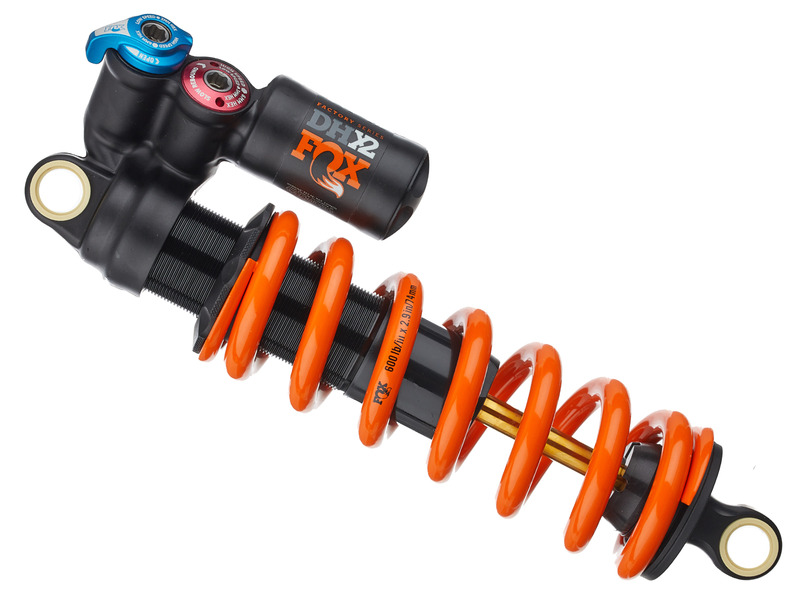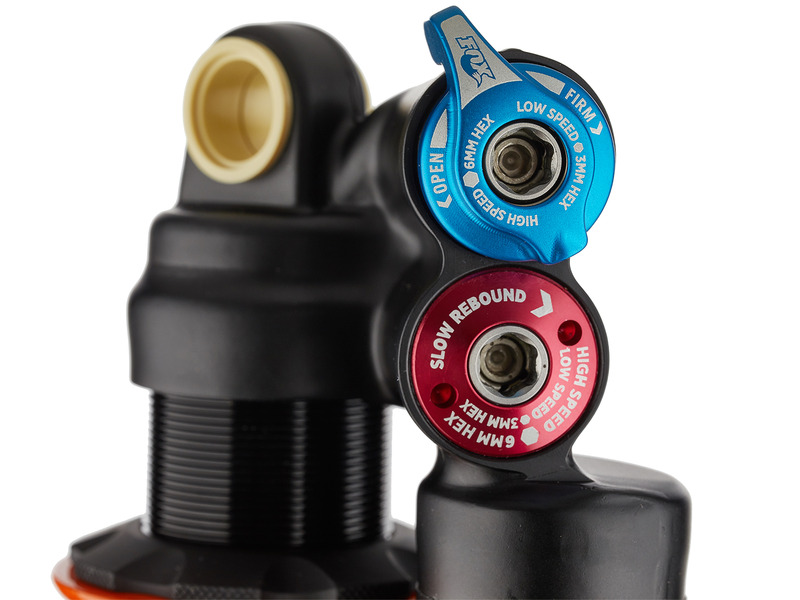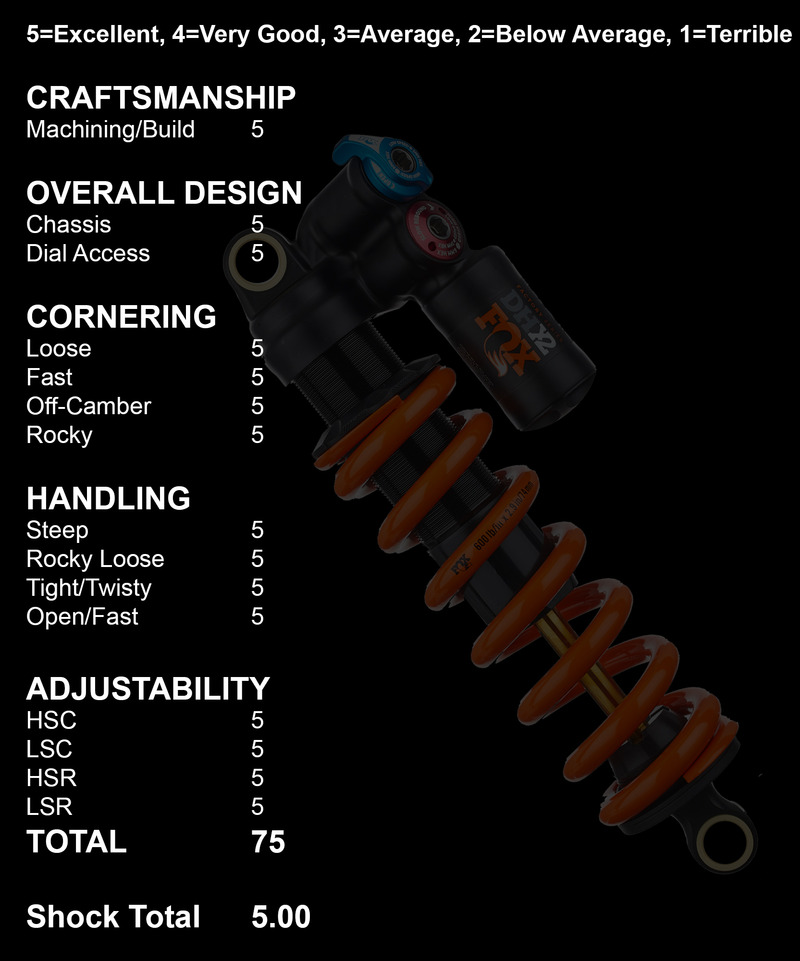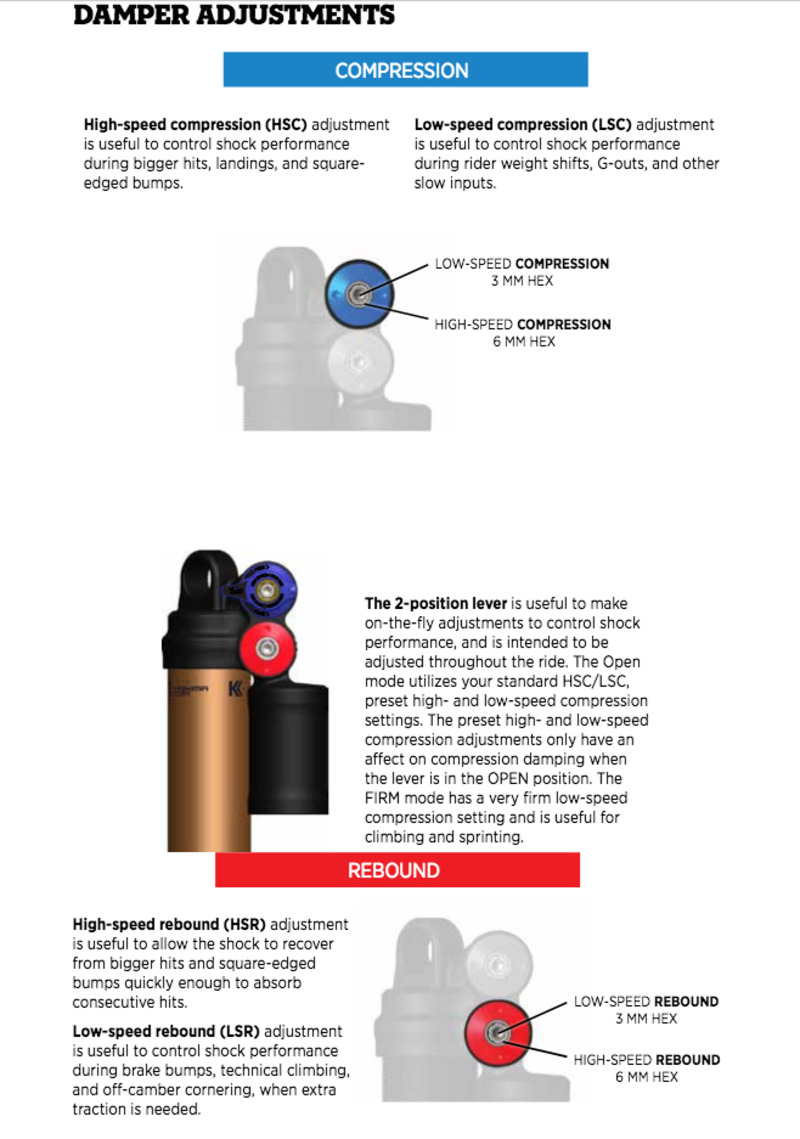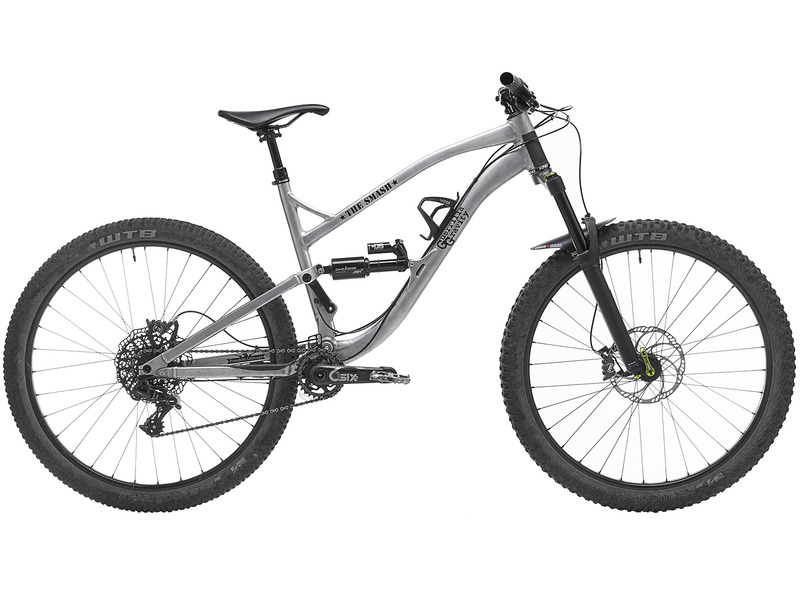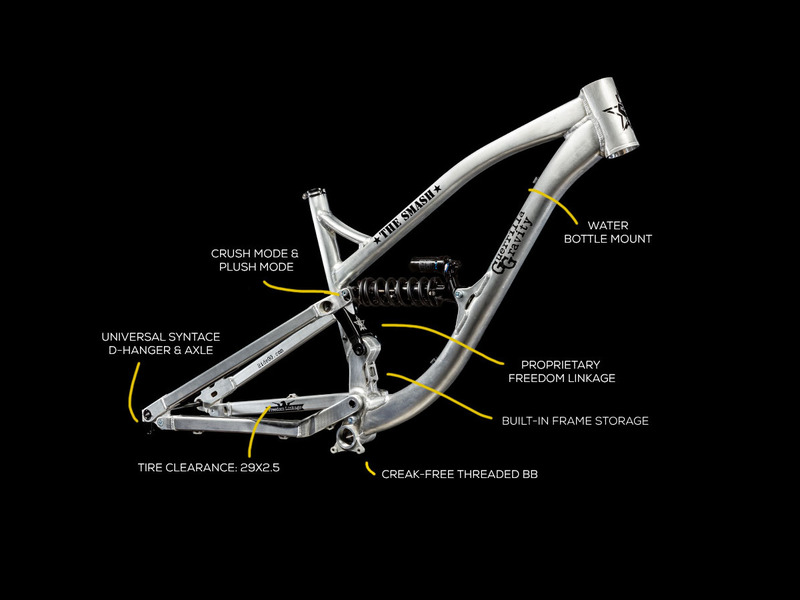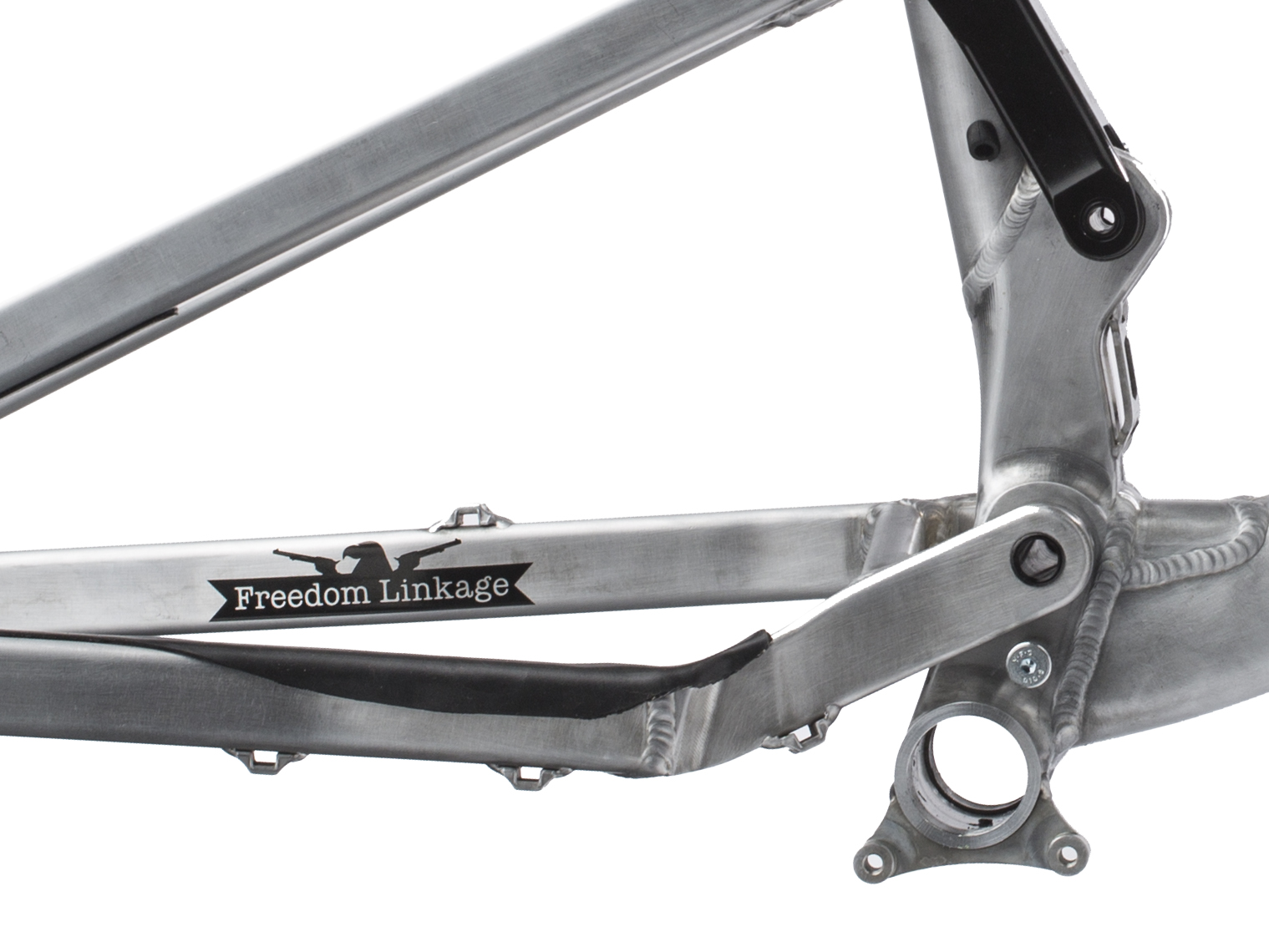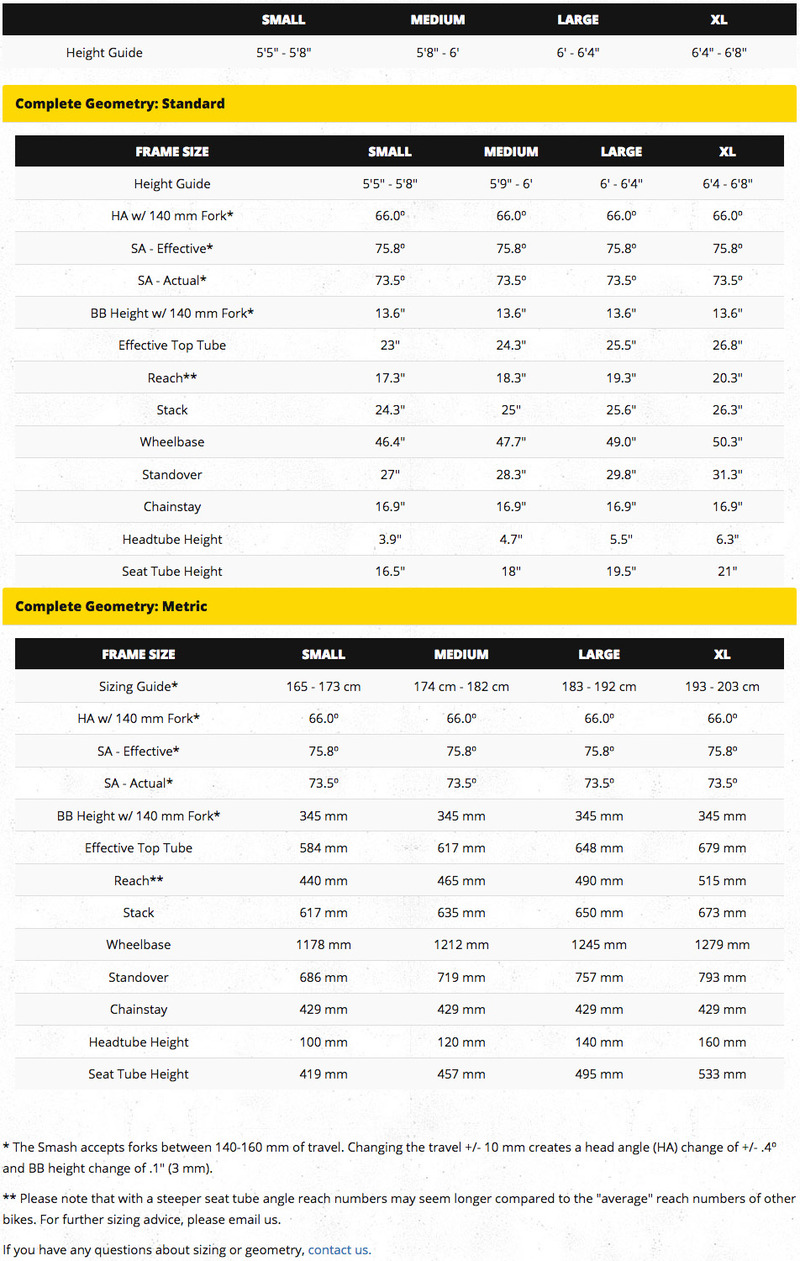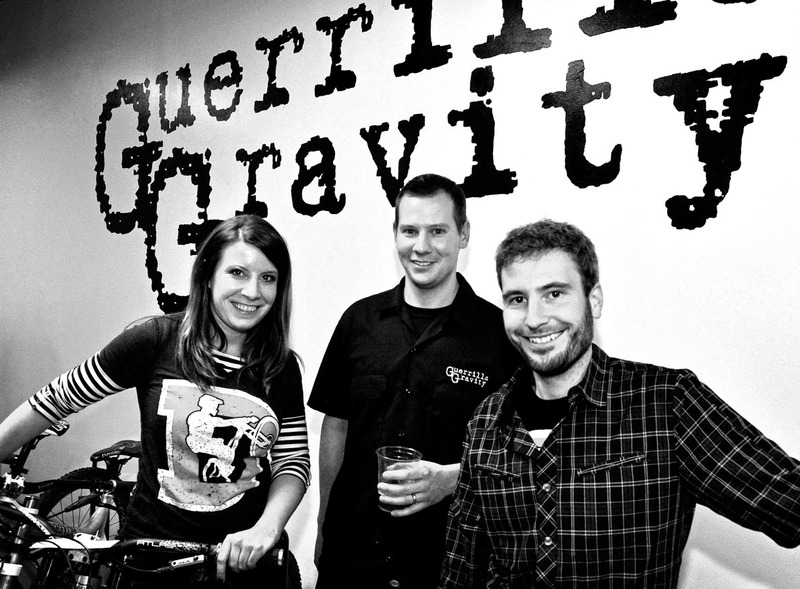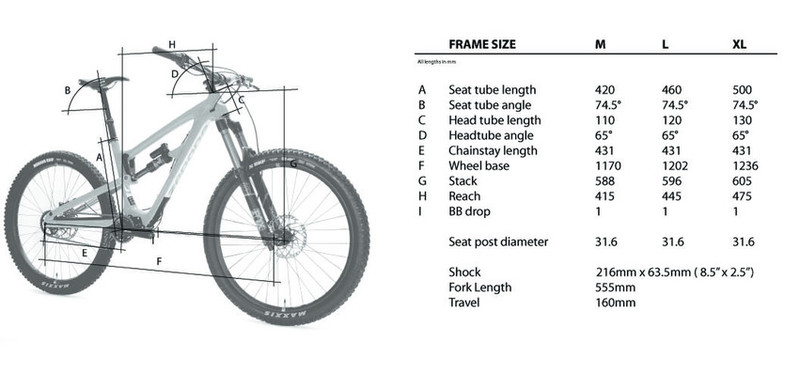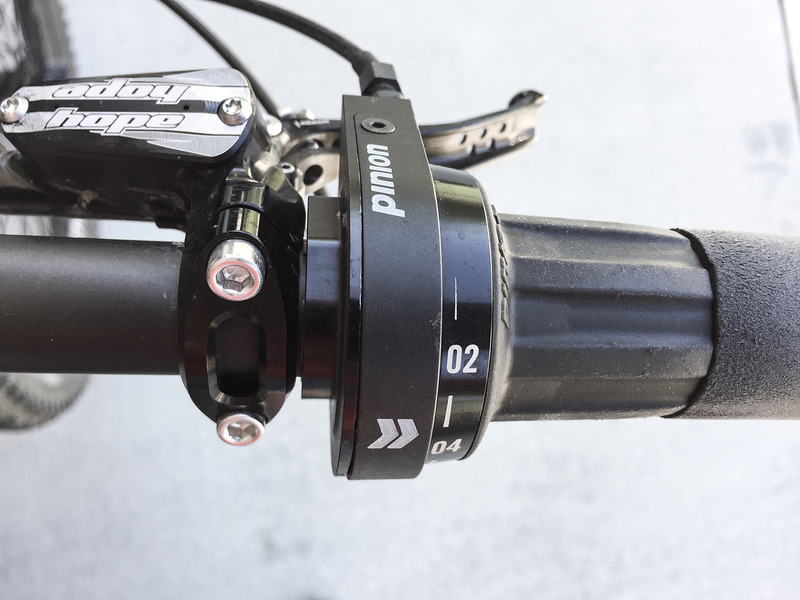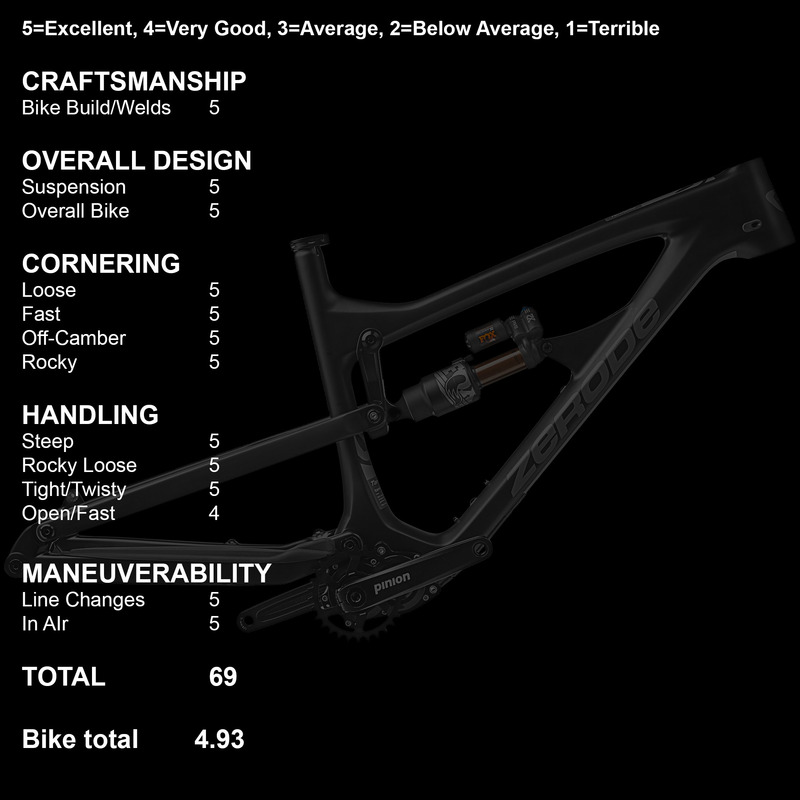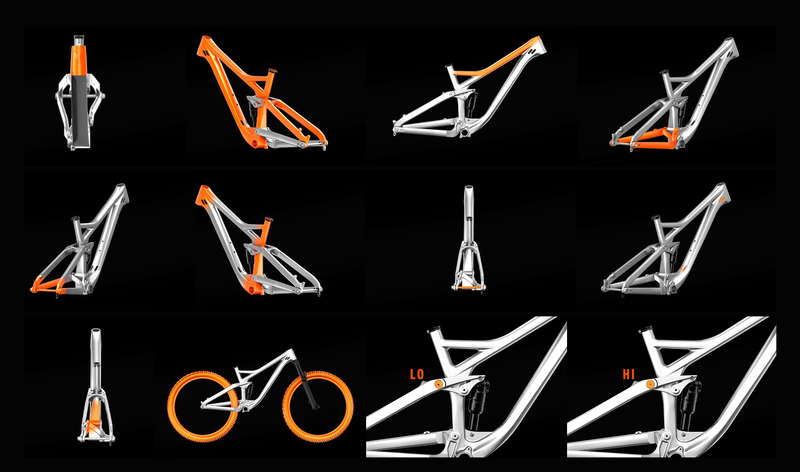Fox DHX2 Test
Fox has been involved in the suspension game since Norba was hating athletes. They have a vast assortment of engineers from different segments to draw ideas from. Over the last ten years, the world of Mountain Biking has been about cutting weight no matter the cost. Many times this will lead to less durable parts, tires that flat or products that have a shorter lifespan. Over the last few years, there has been a renewed interest in coil suspension products. There are numerous reasons to jump to coil-over air including sensitivity, consistent damping under heat, and reliability. Anybody else hates the checking air pressure before rides? Luckily several companies are getting back into the High-End coil shock market. Fox brought the DHX2 over for us to try out and included a lightweight SLS spring!
Fox DHX2 Features
- Available in both imperial and metric sizes
- X2 2-position Open/Firm lever retains high and low speed compression adjustment
- High- and low-speed compression and high- and low-speed rebound adjustment
- Advanced RVS damping system provides more tunability
- High oil flow improves damping control and consistency
- SLS spring option provides titanium weight savings at affordable price
*Coil spring sold separately. Shown with SLS Spring option.
X2
"Fueled by years of RAD development, X2 hits the sweet spot with its a linear damping profile, revised oil flow, and redesigned seals on DHX2 and FLOAT X2 shocks. The wide adjustment range gives riders the support and grip that the trail demands, as well as a more plush and open feel in the initial travel."
RVS
"The Rod Valve System (RVS) provides a more seamless damping transition when absorbing small to large impacts, resulting in faster system response, more control, and less harshness."
SLS Spring
"A proprietary surface treatment and stress relief process removes residual stresses from the spring, allowing them to withstand higher stresses. Each spring is optimized by using a smaller wire diameter and fewer coils, creating a lighter spring."
Standard Sizes
- 7.875 x 2.0 (2-position lever only)
- 7.875 x 2.25 (2-position lever optional)
- 8.5 x 2.5 (2-position lever optional)
- 8.75 x 2.75
- 9.5 x 3
- 10.5 x 3.5
- 30 x 60 (2-position lever only)
- 230 x 65 (2-position lever only)
- 250 x 75 (2-position lever only)
- Optional 2-position Open/Firm lever (retains high and low speed compression adjustment)
- Low-speed compression
- High-speed compression
- Low-speed Rebound
- High-speed Rebound
- Coil spring preload
The DHX2 offers a Firm and Open mode. To get to the trails it is a 3-mile ride on the road. On the way there I ran it open and the way back I used Firm mode. There is for sure a difference but it isn't as massive as what the CCDB offers. If you were riding a pump trail and wanted the bike to be more firm you could ride it in the firm setting easily.
Overall the Fox DHX2 Coil granted our GG Smash more traction and overall an easier initial set up. Some people may have problems with Spring weights but it is very unlikely since Fox offers the SLS spring in 25-pound increments. If you are at the upper or lower weight ranges an air shock may have some benefits.
After spending close to 1 year aboard the Fox DHX@ we had zero issues and it provided very consistent dampening. With its adjustability and avoidance of heat effects on it when doing very long runs we would highly suggest the shock. Saving half a pound or so doesn't seem to make up for the added benefits riders will find while using a coil shock.
 Coil VS Air Shock,
Coil VS Air Shock,  Fox,
Fox,  Fox Coil,
Fox Coil,  Fox DHX2,
Fox DHX2,  Fox Shocks,
Fox Shocks,  SLS Spring |
SLS Spring |
Guerrilla Gravity The Smash Test
Guerrilla Gravity is a small mountain bike company located in Denver Colorado. They were sick of frame prices shooting through the roof while production moved overseas with little, if any, performance increase from year to year. All this while many bike companies grew in size and became more distant from their customers and what they really wanted in geometry and suspension designs. Over the past three years the folks at Guerrilla Gravity have added four more bikes to their stable. We are testing the longer travel 29r called The Smash; they are Strummer fans!
"Surface-To-Surface Missle
The punk rock spirit of Joe Strummer lives on in The Smash, inspiring riders to assail anything in their path. The combination of GG-style geometry and dialed suspension platform creates a 29er you can take on anything from epic big mountain days, to days in the bike park, to your rock-strewn after-work lap. Like all GG bikes, The Smash was designed with versatility in mind. Riders can choose between Crush Mode and Plush Mode to dial in the suspension platform that’s ideal for their local terrain. Crush Mode is more poppy and supportive, while Plush Mode is smoother in the rough--turning rock gardens into a fine velour carpet. Further dial in your ride by choosing an air or coil rear shock. We scrutinized the suspension feel compared to the Trail Pistol and Megatrail, making minute changes that optimize The Smash for its rider. It is softer off the top and through the mid-stroke, yet has more bottom out protection towards the end of its stroke. This creates a platform that is ready for smashing rocks and goin’ fast--up and down.
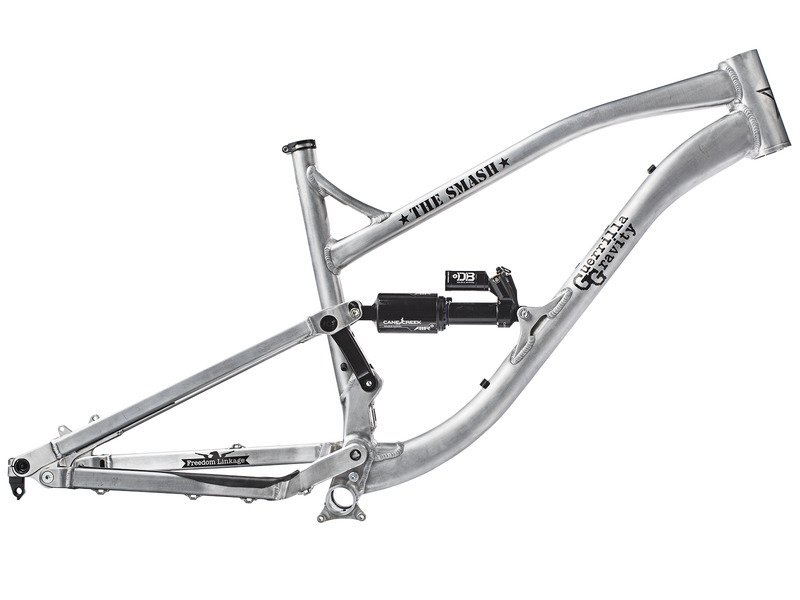 Guerrilla Gravity The Smash Frame
Guerrilla Gravity The Smash Frame
Freedom Linkage
We used our background in racecar engineering to create the Freedom Linkage, a versatile platform that allows you to dial in your ride characteristics based on local terrain and rider preferences via shock tunes. It also utilizes our approach to design that focuses on a high level of refinement to eliminate unnecessary complication. This creates a platform that's made for goin' fast, yet is easy to maintain and built to last. Plus, it's built right here in our shop. Those are pure American welds (f* yeah!)!"
GG The Smash Features
- 140 mm travel
- Crush Mode & Plush Mode
-
- Crush Mode: strong mid-stroke support for flow trails and all-day adventures
- Plush Mode: softer top stroke for smashing rocks and mega-traction
- Freedom Linkage using proprietary Horst Link implementation
- Steeper seat tube angle maintains consistent geo as the saddle is raised and lowered, improves climbing efficency
- NUTS (Necessities Under the Saddle) Bracket keeps your flat changing essentials easily accessible (and lightens your load)
- Bottle mount in front triangle
- 6.6 lbs. (2,995g) frame with hardware (size Medium)
The Smash Specs
- 230x57.5 metric shock
- 30.9 mm seatpost with stealth dropper routing
- 49mm headtube, fits tapered steerer tubes
- ISCG05 chainguide mount
- Threaded 73mm BSA threaded BB shell (greatly reduces creaking)
- 55mm chainline
- ISO brake caliper mount
- 12x148 rear axle, offset 3mm to the driveside for optimal chainline and clearance
- Universal Syntace axle and derailleur hanger
- Max fork travel: 160 mm
- Max tire size: 29 x 2.5
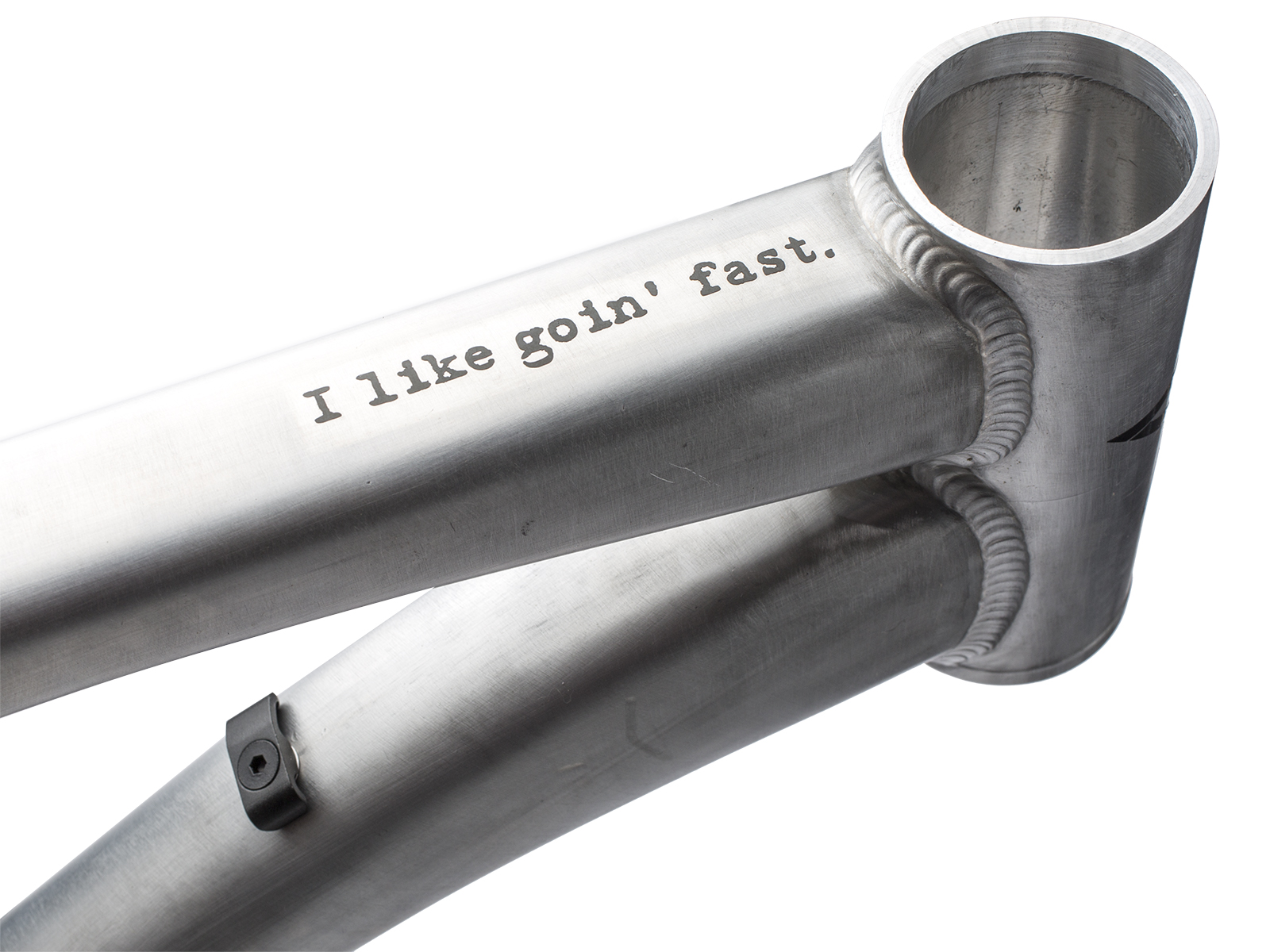 GG The Smash Headtube
GG The Smash Headtube
The Smash Geometry
Long Geometry Benefits
- Security in steep areas
The front axle is more advanced than in a conventional geometry making it almost impossible to go over the bars in steep sections. It feels more secure and confident due to a slacker angle perception.
- Confidence at high speed
The longer wheelbase makes the bike much more stable over any terrain.
- Direct steering
The really short 35 mm, 40 mm or 45 mm stems mean much less handlebar movement to get the same front wheel angle, thus improving steering precision and making the bike extremely reactive.
- Uphill precision
The front wheel keeps the contact on the ground avoiding wheelies due the longer front-center length.
- Stability on rough sections
The FG defends a new weight balance between front and rear wheels making possible to load the front wheel a lot more than with a classic geometry. This possibility changes your handling as it allows for more grip in cornering and better control."
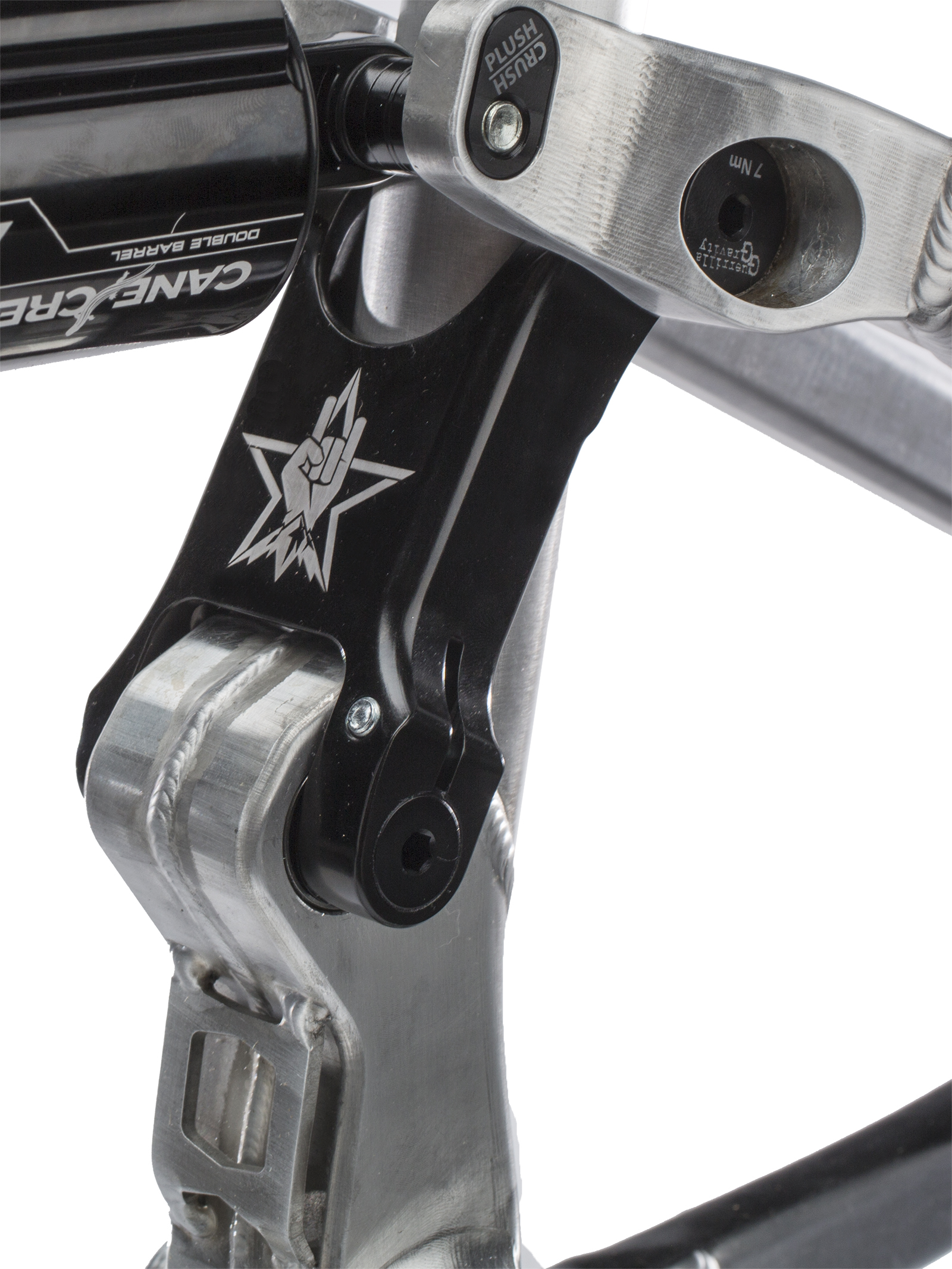 GG The Smash Plush-Crush
GG The Smash Plush-Crush
We once again ordered a size Large. The Megatrail we tested a few years back fit very well and it had similar reach numbers to the current Smash. The Smash has 29" wheels so it would be a bit taller than the Megatrail. Being six feet tall and with the reach numbers of the frame we once again opted for a 35mm stem. There where no issues putting the bikes together. Everything went together easily and having a threaded BB is the way all bikes should be. After 4 months of riding not a single noise! Also of note is the 1.5 head tube this can be somewhat limiting on headset options. We ran with a Chris King Inset5 Tapered 49mm Headset. We opted to run a more aggressive build on the bike and it's total weight was 32.3 lbs. See the build below.
- Guerrilla Gravity The Smash (LG)
- DVO Diamond 160mm (110 Boost)
- Chris King InSet5 (49mm)
- Race Face SixC Cranks 30 (170mm)
- Race Face Atlas Stem (35mm)
- Race Face SixC Bars 35mm (20mm)
- Fabric Scoop Shallow Elite
- Magura MT7 Brakes With HC3 Levers (200mm Rotors F/R)
- Hope Pro 4 Rear (12mm by 148mm)
- Hope Pro Front 15mm (110 Boost)
- Stan's No Tubes Flow MK3 29"
- 9point8 Fall Line Dropper Post (200mm)
- WTB Vigilante Front (2.3)
- WTB Breakout Rear (2.25)
- SRAM GX Eagle 12 SPD Rear Derailleur
- SRAM GX Eagle 12spd Shifter
- SRAM XG GX 10-50 Cassette
Guerrilla Gravity designed the 140mm Smash with the gravity rider in mind. The large we tested has a 1245mm wheelbase and with our 160mm DVO fork out front it is closing in on a 65 degree HA. Longer bikes like this give riders a larger margin of error. When shifting your weight around you will notice that you have to go further towards the front or back to get the bike to respond, essentially making the sweet spot of The Smash much easier to stay centered within. With head angle we built it out with the bike felt good. Riders have a 1.5 head tube at their disposal, so running an Angle Set is always an option to make it even more slack. Climbing was not an issue and the front of the bike didn't show any tendency to wander.
We opted to run The Smash in the Crush Mode to provide us with more resistance to pedal bob. After doing five rides we decided that we could run the bike in Plush Mode and it provided plenty of support under power in that mode. Guerrilla Gravity seems to have nailed the pedaling platform on their frame designs. Running the shock in climb mode helped on long drawn out climbs but took away some of The Smash's sensitivity and traction while climbing on rocky terrain.
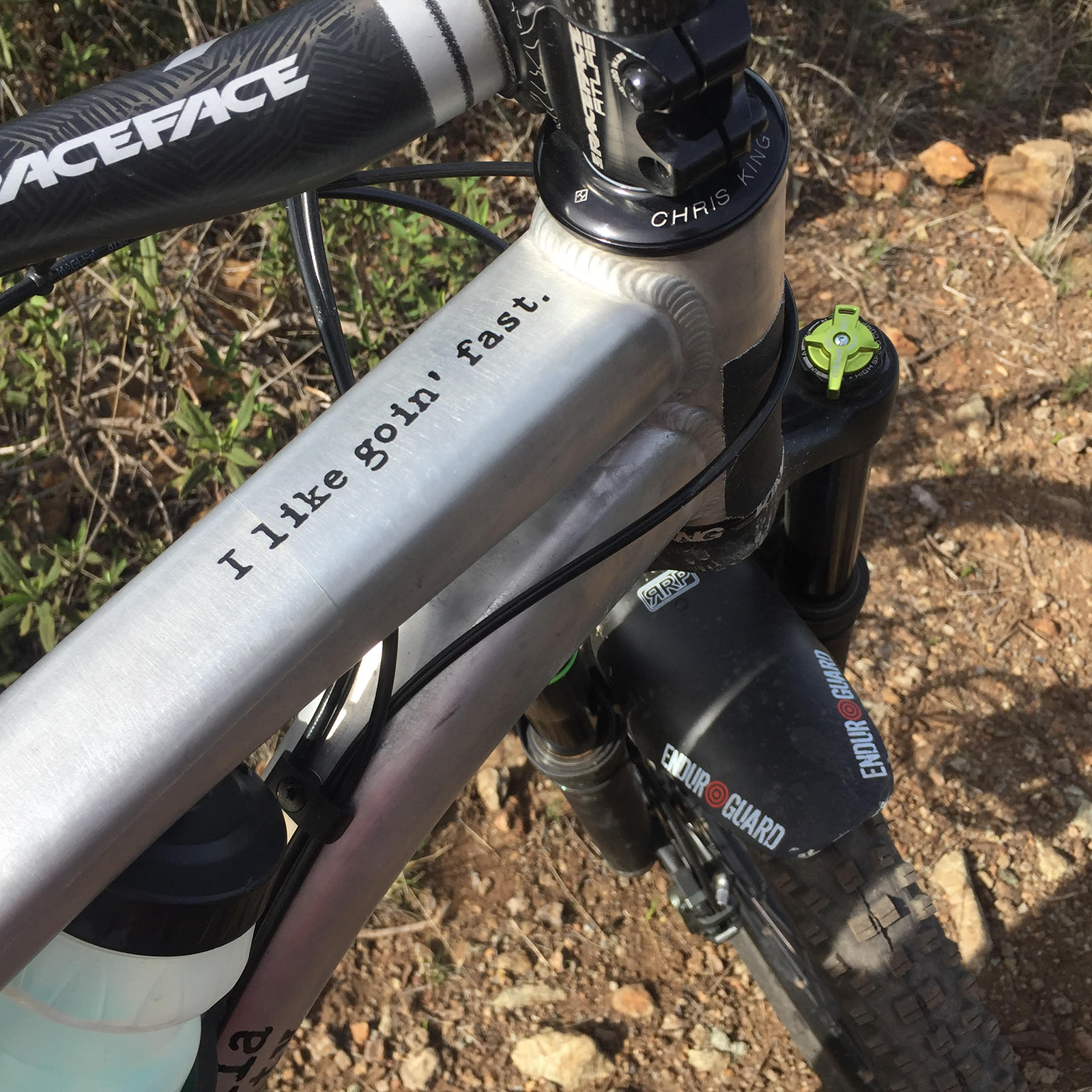 GG "I Like Going Fast"
GG "I Like Going Fast"
Guerrilla Gravity is at the forefront for Forward Geometry here in the USA. They have been doing it for almost 4 years now. During that time other companies have made their bikes longer as well. Look carefully at some of these companies and you will see their sea tube angles are pretty slack this is an easy way to get a longer reach number while the wheelbase stays the same length. GG is adamant about using steep seat post angles on all their bikes. This makes for a bike that doesn't dramatically change when a rider has a seat all the way up and then drops it down real fast. Also in many instances taller riders complain of knee pain while riding bikes with slacker seat angles. Another benefit of the steeper angle is keeping the front end down on steep climbs.
The ride the Smash offers is stiff! We couldn't detect any flex in the frame during hard cornering. Having such a rigid chassis will transmit a bit more trail into the handlebars than a more forgiving chassis but will also grant the rider with instant responses to their inputs. Another thing very much worth noting about the frame was their decision to use a threaded BB and a 1.5 steer tube. Thanks GG for making our bike assembly easier and also helping to keep it quite for a very long time. Looking at the bike and its use of large bearings, high grade hardware, and avoiding the latest in cycling standards it becomes apparent it was designed with the input of experienced mechanics.
Guerrilla Gravity has once again created another awesome shred machine. Their Homage to arguably one of the best rock bands in history with The Smash name is just icing on the cake. This doesn't feel as aggressive as The Megatrail did in gravity mode and this probably comes down to the ultra low BB the 650B bike had on it. I think the HA and WB length of The Smash are very good and comparing it to the other aggressive 29" enduro bikes we have tested in the past it does many things better. As we mentioned earlier The Smash is one hell of a pedal machine. While wide open the shock bobs very little and still provides a very active suspension. Putting the shock into pedal mode just eliminates almost any motion out of the frame while putting down power. If you run the frame in Crush mode it provides the rider with even more mid stroke support and gives a slightly firmer feel to the ride.
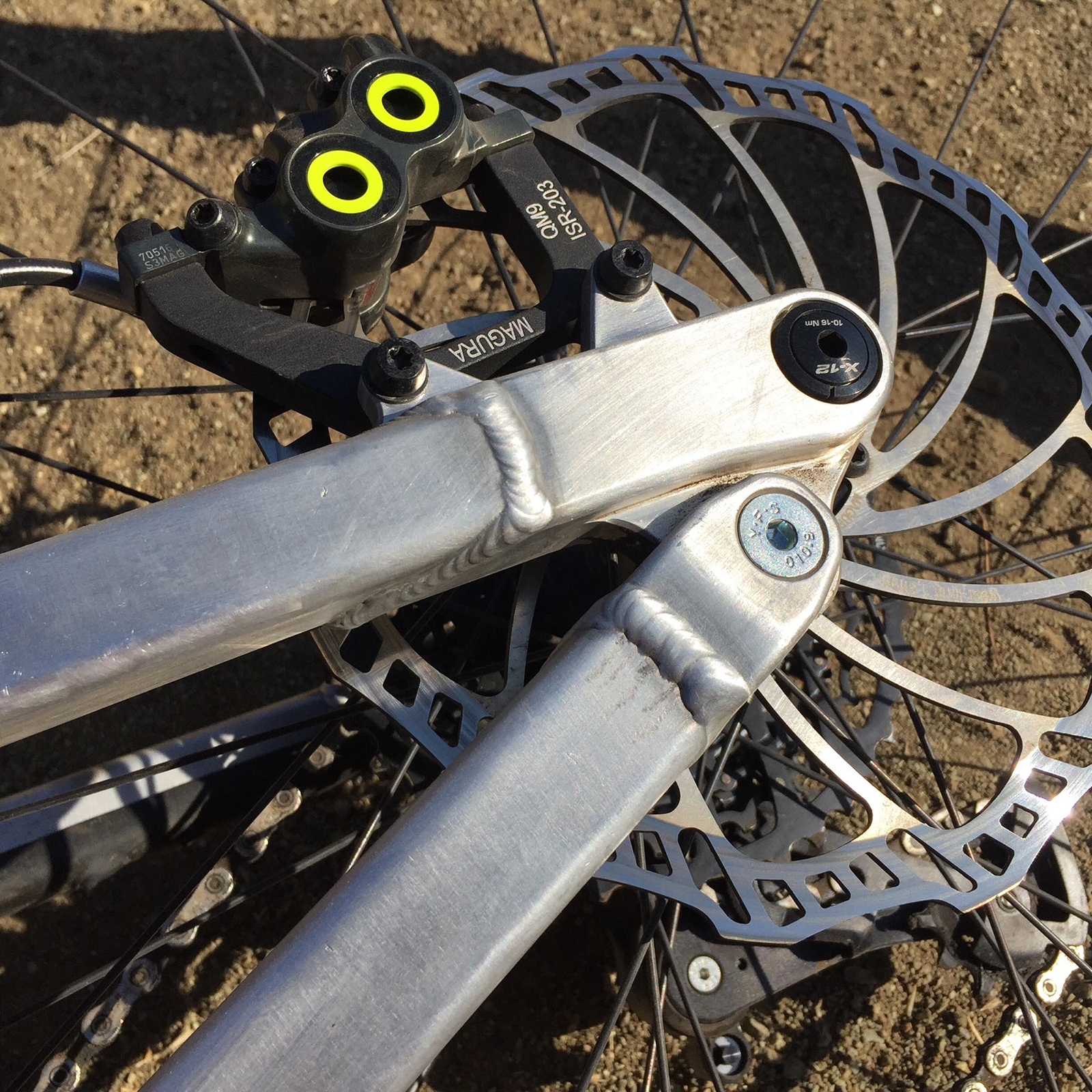 FSR? Freedom Linkage yo
FSR? Freedom Linkage yo
Climbing aboard The Smash was a relaxing experience. Just point the bike where you want to go and it will take you there with ease. Once you begin climbing steeper grades it will become apparent that the long wheelbase in conjunction with the steep seat post angle are doing their job of keeping the front wheel down and providing plenty of traction for the back wheel. Our bike was in the mid 32 pound range and could have been a bit lighter with different suspension and cockpit choices. This didn't take away from its ability to get the rider to the top of the hill. In fact this is the same weight as every other 29" bike we have tested so far.
We finished the bike while it was raining out. So naturally we took to the hills. There are two trails in our area that are fine to ride while still wet. The closest trail is also the shortest it climbs 700 feet in just over a mile. It is tight singletrack that is loose and rocky. This descent allows fast riders to break the 30 mph mark. Luckily for me I have never gone above 26mph on this trail. We had the bike in Crush mode this first time out and it provided plenty of traction and the suspension to handle anything on this trail. It quickly became apparent that the bike comes alive at higher speeds. It never felt twitchy or like it was being bucked around. Once I got to the bottom of the wet hill I was 10 seconds back from my fast time. That is pretty good considering I have not ridden in close to two months.
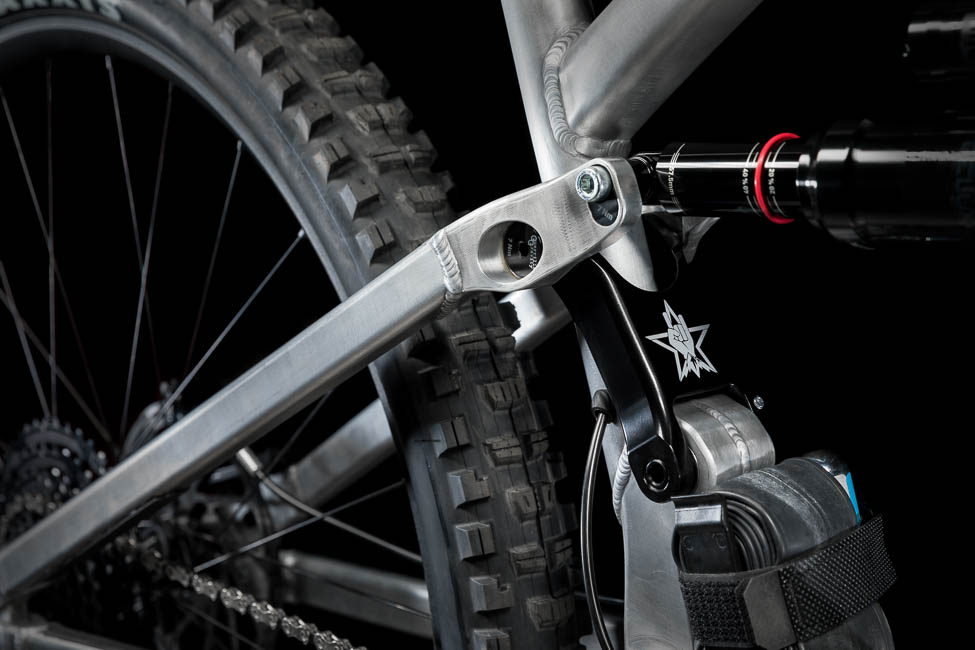 GG The Smash has NUTS
GG The Smash has NUTS
Across the valley from this first trail is another that is much longer and has way more turns in it. Also at the bottom of the trail you have to climb 100 or so feet out to finish it off. This gives a good idea of a bikes cornering ability and some idea of how it will handle g-out situations. At the very start of this trail is a hard left in rocky terrain. then it sends you through a short rock garden and then into a high speed off camber section. The Guerrilla Gravity Smash made fast work of the first corner and shot me into the rocks at a fast rate. Wagon wheels rolled over them without any issue. After you finish the high speed part the trail enters a section of turns and then sends you into an abrupt short uphill that acts as a g-out. The bike stuck well in the turns and I was reminded to keep some weight over the front tires to keep the traction. Overall The Smash showed it could tackle turns, rocks and high speed sections with ease. The climb out at end was a snap and I could taste the blood in my lungs at this point so I know I had a good go.
Another nearby trail is littered with zig zag corners for the first third of it. The corners are very sharp and it is obvious the trail was made this way to keep MTB speeds down. Many faster riders in the area despise this trail but will ride it on occasion. I try and get up here once a week. Turning is a weak part of my riding so spending time up here helps me with that. Considering I am riding a 29" bike with almost a 50" wheelbase tight sections should be The Smash's achilles heel. This turned out not be the case while riding The Smash on this twisty hill. All the corners have rocks scattered throughout them to test out a bikes suspension. I had one time where my back wheel made contact with the inner side of the turn. More than likely this was rider error and was a result of turning to early. I was able to get times within 10 seconds of my fastest after doing the trail 3 times.
 The Smash has new sticks and colors
The Smash has new sticks and colors
Conclusion
Once again Guerrilla Gravity delivered a very high quality product that was made in country and built with loving hands. Choosing to use a 1.5 head tube combined with a threaded BB helps the bike go together smooth and offers many options for the owner to choose from. Being able to see the work that goes into making a frame is something that is lost when looking over a plastic frame. We had a small issue when installing the dropper post cable into the frame. It got hung up while trying to press the post into the frame. We just had to press the housing into the seat tube so it would clear the cable hole and not get hung up. The frame offers a bunch of clearance for the rear tire. We where running a 2.3 rear tire and had plenty of space on both sides.
Overall the Smash is a confidence inspiring Enduro bike that is built and descends like a mini Downhill bike. This is a bike that can last for years of trail riding without issue. Having a bike that lasts more than a few seasons under serious riding is a rarity these days. If you are looking for a park capable 29" Enduro bike that you can ride just about anywhere that will stand the test of time and not hold you back in anyway the Smash is a bike you should take a serious look at. We would gladly recommend the Guerrilla Gravity Smash to a friend it has been a blast to ride and is probably gonna stay awhile. Another very noteworthy feature of Guerrilla Gravity bikes is their low price point. Having a USA made frame for around $2000 is a great value.
Guerrilla Gravity The Smash Gradecard
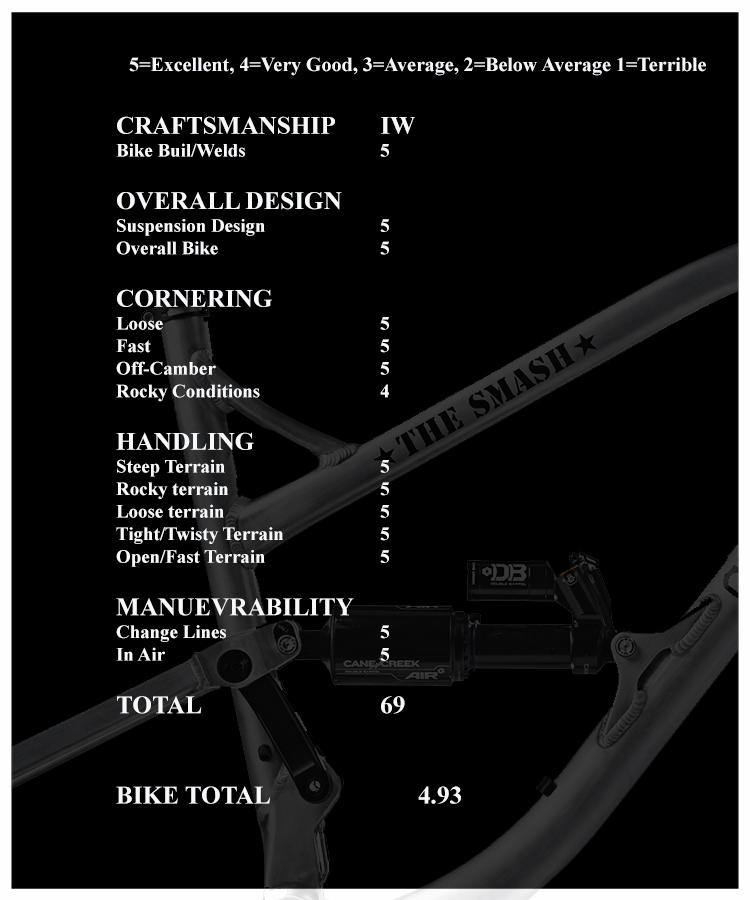 GG The Smash Scorecard
GG The Smash Scorecard
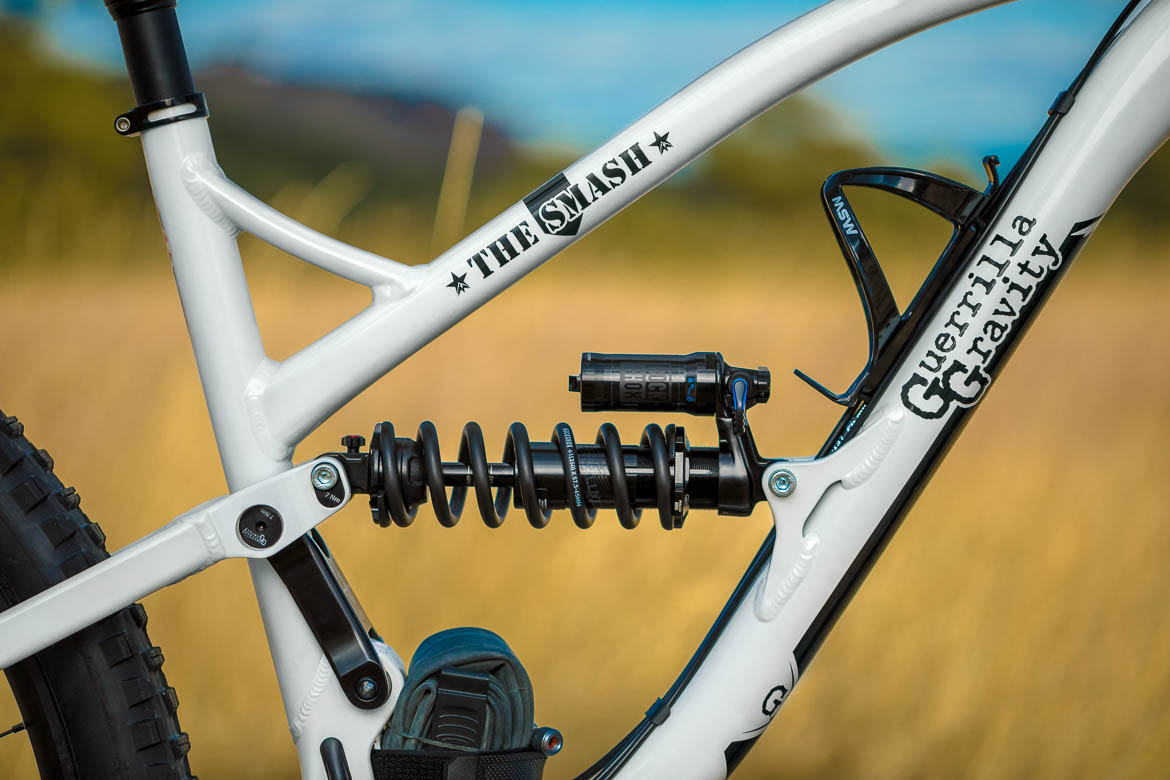 The Smash with coil shockGo check out the Guerrilla Gravity Smash
The Smash with coil shockGo check out the Guerrilla Gravity Smash
Guerrilla Gravity Q & A
3. Break down your team for us and what they do?
4. How did the idea for The Smash begin?
11. Any chance you guys can get the water bottle mounts down closer to the shock to clear a big bottle? Us fat old guys will love you for it.
12. Care to elaborate on Geometry used on the Smash?
Sometimes the “internet riders” seem to think our cockpit geometry is way too long, but literally every rider to throw a leg over aSmash feels comfortable instantly. By utilizing a roomier cockpit with a shorter stem you have a better, more stable center of balance and room to freely use body English. It’s also preferable for getting rowdy on the downhills, as your weight is more centered and not as far forward, over the bars.
13. Rocks or jumps?
Zerode Taniwha Test
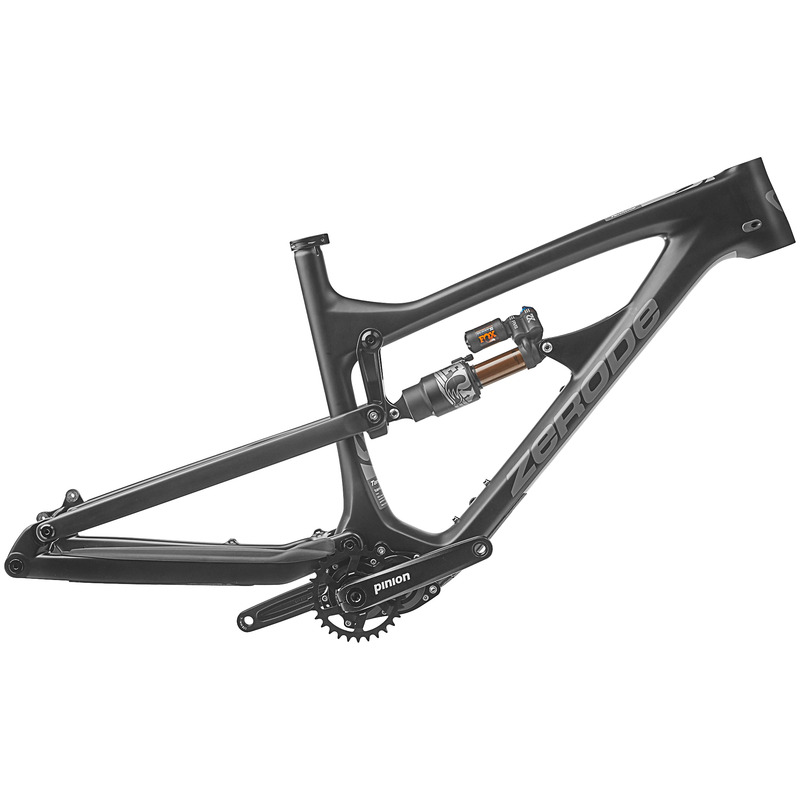 Zerode Taniwha Drive Side Frame
Zerode Taniwha Drive Side Frame
Zerode bikes launched in 2011 and have been producing gearbox Downhill Bikes for 5 years now. During that time there has been a rising demand from customers and others interested in dropping the traditional derailleur on their AM/Enduro bikes. These systems inhibit the suspension, add weight to the rear end and allow a somewhat vulnerable mechanical piece to dangle a few inches from the ground. We would like to introduce you to The Taniwha a 12spd Pinion Gearbox, Carbon Fiber trail slayer.
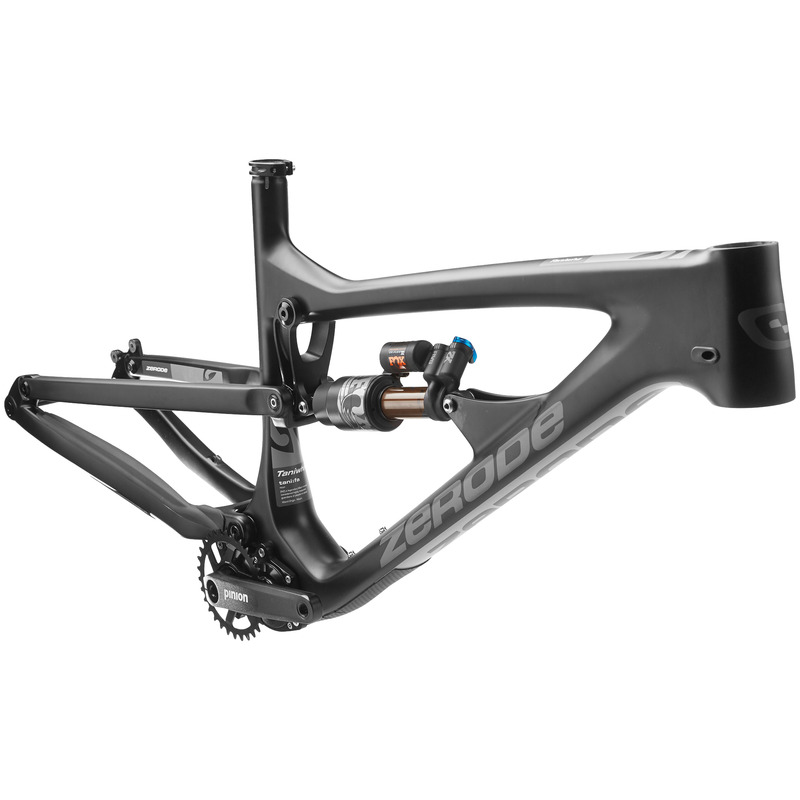 Zerode Taniwha Drive Side Angle Shot
Zerode Taniwha Drive Side Angle Shot
Rob Metz has spent the last 5 years producing Zerode downhill bikes. This was a high single pivot gearbox bike. Well, the time has come for Zerode to release the highly anticipated trail bike. Please allow us to introduce to you The Zerode Taniwha. This is a 160mm, 650b wheeled bike sporting a 65 degree HA and using a Pinion 12 spd gearbox that is mounted into its Carbon Fiber frame! For the “enduro” frame Rob found it best to go with the more common lower single pivot design. Once again you will not need a derailleur, cassette, shifter, chain guide, cranks or BB for the bike.
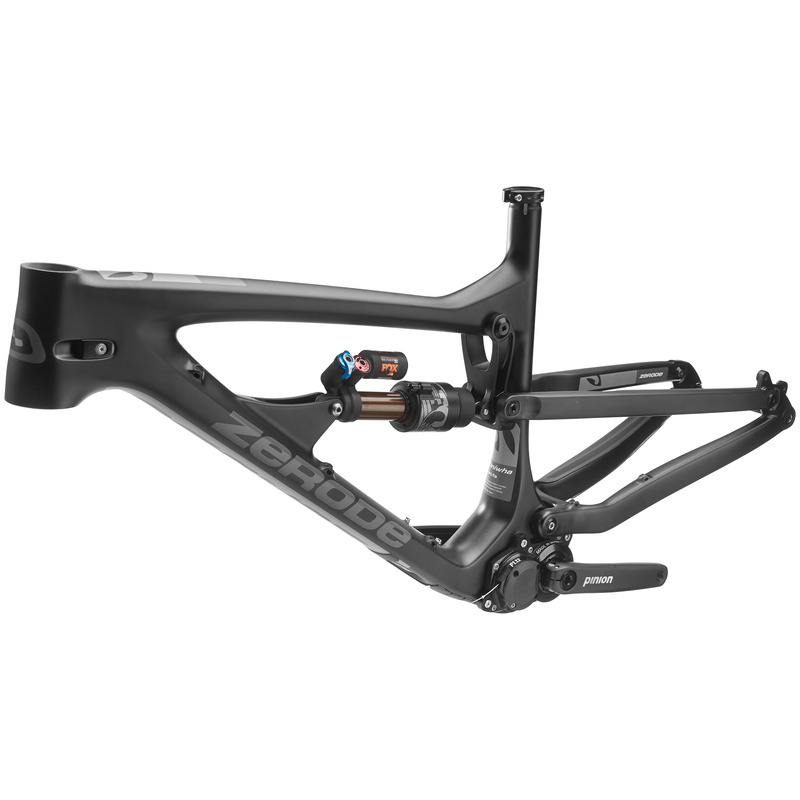 Zerode Taniwha Non Drive Side Angle
Zerode Taniwha Non Drive Side Angle
Zerodeusa began importing and distributing Zerode bikes back in 2011. At that point it was Zerode's high pivot idler bike called the G1. The Mountain Bike market began to change around this time and many people began to trade out their downhill bikes in favor of long travel trail bikes. Once this Enduro craze hit Zerode knew that a trail bike would have to happen sooner rather than later. Rob started contacting carbon manufacturers in Asia about producing small batch runs of the Zerode trail bike. Santa Cruz agreed to help Rob out and sample frames began production shortly after. Take a look at the Geometry of the Zerode Taniwha compared to the Santa Cruz Nomad and you will notice they are nearly identical in the size department.
Zerode Taniwha Features
- Carbon Frame
- 650b
- 12spd Pinion Gearbox
- 31.6 Seatpost
- 142mmx12mm rear hub
- Water Bottle Mount
- 430mm CS Length
- 74.5 Seatpost Angle
- 65 Degree HA
- 600% Range
- Equal Gear Steps
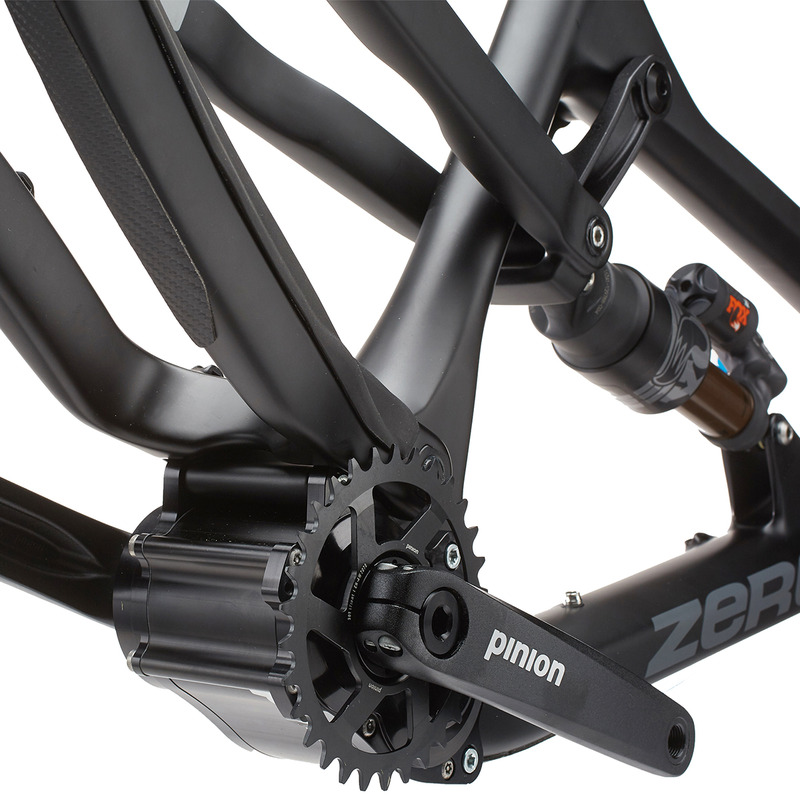 Zerode Taniwha Pinion Drive Side Detail
Zerode Taniwha Pinion Drive Side Detail
The suspension design of the Taniwha is a simple linkage driven single pivot. Rob explains the reason for this is that it has the exact same Anti-Squat (100%) throughout the whole range of travel. This also allows for a very easy suspension set up. The Zerode has a slightly progressive design that the rider can fine tune easily with HSC/LSC and shock spacers. After riding the bike for almost 6 months we can say with certainty that the pedaling feel of the bike is totally unique. It offers tons of traction and never stiffens up while going over obstacles.
 Zerode Taniwha Pinion Non Drive Side Detail
Zerode Taniwha Pinion Non Drive Side Detail
Many gearbox advocates like to press the point that you eliminate the most fragile part of the Mountain Bike when using a gearbox. This is very true to a point but not the reason Rob Metz made Zerode. His driving reason for going the gearbox route was to eliminate unsprung weight from the drivetrain and by doing so dramatically improve suspension performance. The combination of saving 1.5 pounds off your back wheel and keeping chain driven suspension effects away provides a bike that has some of the best feeling suspension that we have ever ridden. It is very sensitive to small nuances on the trail. It feels as supple as a downhill bike going along chatter filled terrain. Having the ability to shift while coasting is another benefit of using a gearbox system. This can allow riders to change gears over the roughest terrain or while in mid turn.
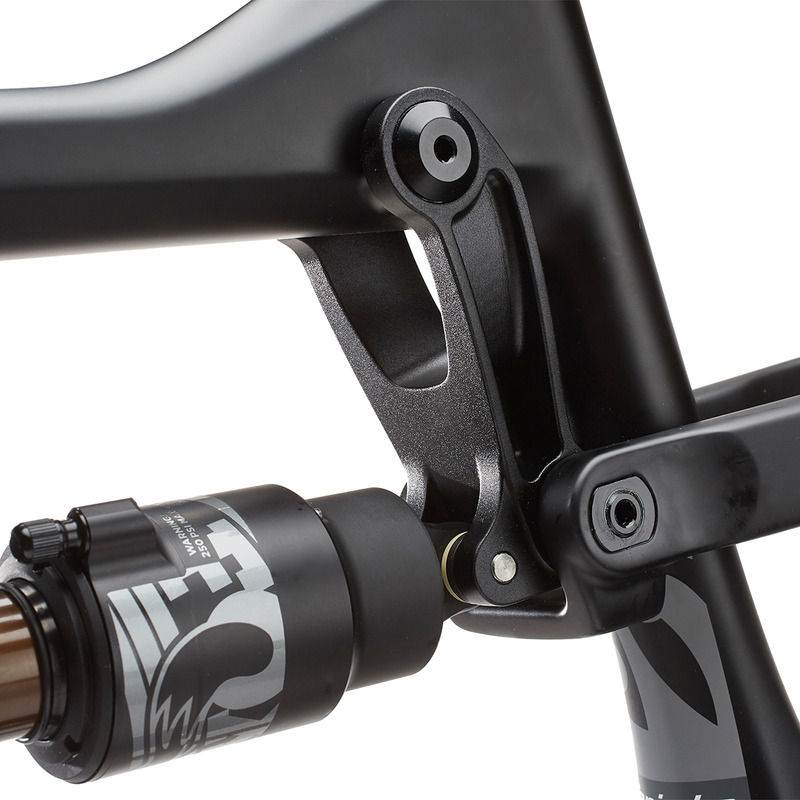 Zerode Taniwha X2 Shock Mount Detail
Zerode Taniwha X2 Shock Mount Detail
Building the Zerode Taniwha was trouble free. It went together easily and we just had to watch the cable install video on the Pinion Website a few times to get that running smooth. The i9 305mm Enduro wheels are strong trail wheels. These are a bit stronger than was probably required and we could have laced up some lighter custom wheels and saved some weight. We opted to build the bike with almost the exact same build that we used on our Evil Insurgent Review. Overall our complete Zerode Taniwha came in at 34.85LBS and we are running WTB Convict/Trail Boss front in rear both in TCS casings. So these are about 1.5 lbs heavier than a Maxxis set-up would be. So, in theory, you could build one close to this at the low 33lbs range. Just an FYI our XL Insurgent weighed mid 32LBS with a very close build so about 2.25 lbs lighter in a frame size bigger than the Taniwha we tested.
"Fundamentally the Zerode Taniwha is about making the mountain biking experience better. Nothing inspires us to ride more than a quiet, low maintenance, confidence inspiring bike
The 12 spd pinion gearbox offers a huge spread of gears that goes well beyond today’s 1×11. Whether you are grinding up an epic backcountry single track or blasting down a high speed fire-road there is a gear to do the job. An unexpected pinch climb will never be a problem again, changing gear is effortless and immediate.
A significant reduction in unsprung weight ensures suspension performance that is undeniably better than any Enduro bike equipped with a rear derailleur. Symmetrical spoke angle ensures a very strong, light rear wheel that further improves suspension performance.
A simple, effective and proven suspension platform combined with a fixed chain line optimizes pedaling performance through the entire travel range. It is difficult to approach the elegance and performance of this layout with any virtual pivot design.A sleek full carbon frame offers excellent stiffness, reduced weight and flawless beauty in a modern geometry.
Maintenance and tuning of gears are almost nonexistent, sprocket and chain life are massively extended. On a Zerode, that brand new drivetrain feeling happens every day.
For those that ride for fun, the Zerode Taniwha will inspire you to ride in any conditions on any trail. If you are racing, whether it for an EWS podium or for bragging-rights amongst mates, the Taniwha provides an edge your competition won’t have.”
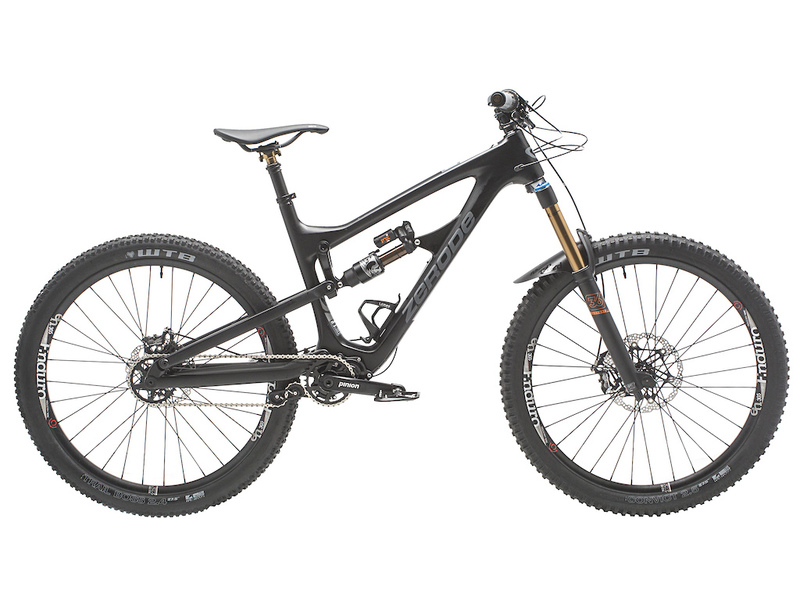 Zerode Taniwha Pro Build Complete Zerode Taniwha Pro Build
Zerode Taniwha Pro Build Complete Zerode Taniwha Pro Build
- Zerode Taniwha Large Frame Fox X2
- Fox 36 Rc2 Fork
- Chris King Inset
- Gamut Cillos Stem
- Enve DH Bars
- Hope Tech 3 E4 Brakes 203/183
- Industry Nine 305 Enduro Wheels
- Fox Transfer 150mm Dropper
- WTB Convict TCS-WTB Trail Boss TCS
- Fabric Saddle
- ESI Grips
Zerode Taniwha Geometry
I took the Taniwha out on a trail that climbs about 700 feet in just over 1 mile and I could tell The Zerode had a 4 lbs weight gain over the Django I tested earlier. It's pedaling ability was good even with the X2 shock in open mode. For about 85% of the time while climbing we used the pedal feature on the X2. But you could tell it had more weight compared to the last bike I was on. It also offers a bit more traction on the climbs as well.
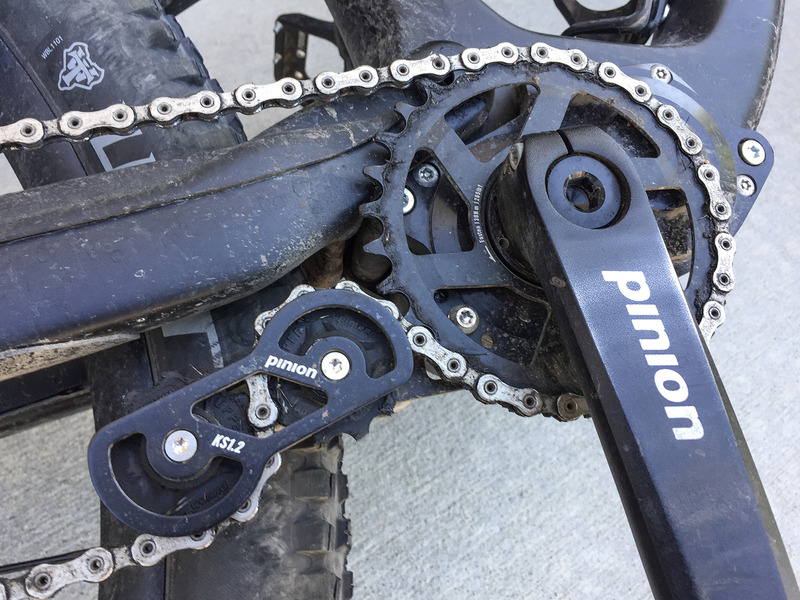 Taniwha Pinion Tensioner Detail
Taniwha Pinion Tensioner Detail
Once at the top I strapped on my bell and goggles and got ready to drop in. The first part is high speed and fire road width with a good scattering of rocks. I could tell right away The Taniwha was more forgiving when hitting bigger rocks than the previous test bike. It didn't have the roll over ability as the Evil Wreckoning but the 29" wheels gave that bike a large edge. The suspension on the Zerode did smooth the entire trail out better though.
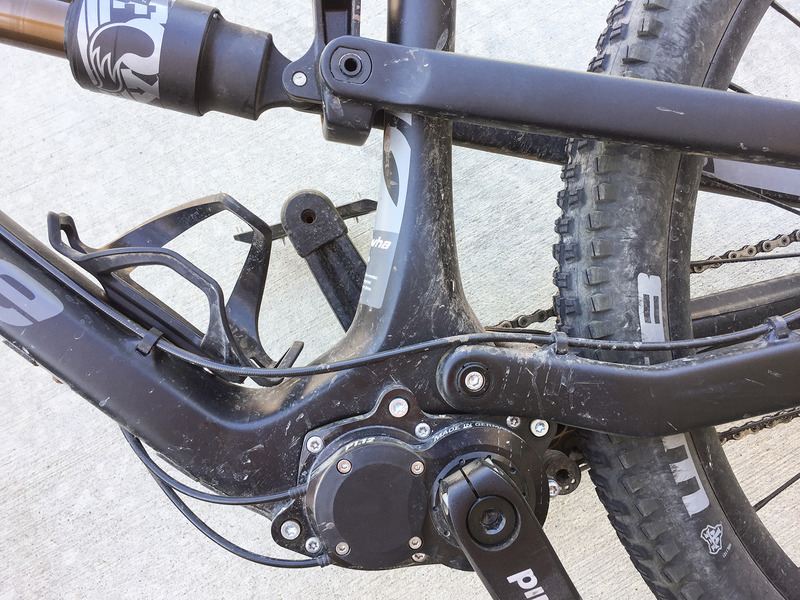 Zerode Taniwha-Pinion Mounting
Zerode Taniwha-Pinion Mounting
The trail takes a hard left through rocks and enters a very high speed off camber single track section. there are some large rocks here you dodge and weave your way through. After that, it goes right back across the mountain through some ruts and up and over a steep roller that acts as a G-out and typically uses most of a bikes suspension when hitting it at speed.
Zerode Taniwha Pronouced TANIFA
This trail is somewhat smooth compared to others in the area. Also towards the end, you have to climb up some twisty single track to finish it off. this is where we used the ability to shift without pedalling in the very tight turns and come out in a gear that was easy enough to climb with. Overall the trail was a little too mellow for The Taniwha. You could tell it wanted something much rowdier to show off its unhindered suspension.
Taniwha Pinion Cable Routing
About 300 feet up from the first trail is one that is rock filled for about 500 yards and enters a fast twisty section of trail for the last mile or so. This is a good trail to get a feel for how a suspension system will perform. The entrance to this trail you can hit pretty high speeds my best ever was 28mph and I was just under that aboard The Taniwha. The bike felt stable going fast and there are rocks scattered all across this double track section of trail. It seemed to offer good traction and felt very planted in the high-speed quick turns in this section.
There is a small climb up that takes you to the rocky part of the trail. You enter this on a fading right-hand turn that drops you into the rock garden. The rocks range in size from marble up to knee high here. The fastest route is a straight line down the middle and linking the sections together by hopping over and down the larger embedded rocks. Overall I would say the suspension worked remarkably well. The trail felt smoother than it did on many of the other trail bikes we have tested. Maybe saving the weight off the back wheel does translate into better trail manners after all. This trail has some loose turns and the Zerode Taniwha seemed to offer a fair bit of traction. It wasn't as much as a 29" bike but more than a normal 650B seemed to offer. This also can be attributed to the suspension sensitivity and the low center of gravity. There are a number of fast turns back to back in this trail that you can hop the bike into and hope it grabs traction. The low center of gravity really seemed to help the bike find grip easier here than many of the other 650b bikes we have tested. Moving around on the Taniwha to effect front end traction or lift the front wheel was very easy. The window of balance on the bike was huge. Keep in mind this frame is a fair bit shorter than the last two bikes we have tested so this feeling can directly be attributed to the gearbox being down low on the frame. The Zerode proved to have a stiff frame. I never noticed The Taniwha showing any kinds of flex in tight turns or even high-speed rock filled ones.
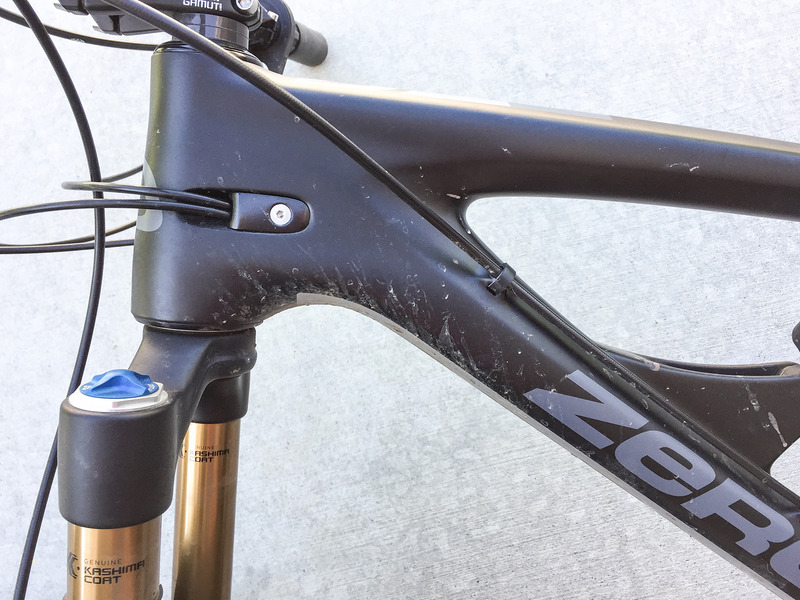 Zerode Taniwha Internal Routing
Zerode Taniwha Internal Routing
So the Zerode Taniwha descends well in part due to having a very light rear end and one of the lowest centers of gravity around. Also, the simple suspension design works very well at eating rough terrain and is one of the easiest to set up. But how does the Taniwha climb or pedal? Let us get this out of the way now. You can tell it has a gearbox when pedaling on the flat ground. It makes a bit more noise than a standard bike with a full chain guide. It isn't as loud as the old school Mr. Dirt guide but it makes noise just a slight whirring from between your feet. Pinion claims the gearbox gets smoother as you rack up the miles. We put about 500 miles on the bike and would have to agree with them. It did begin to make less noise and seem to offer a bit less resistance. Honestly, if there is a bit a drag while riding the Zerode Taniwha it is very mild. In fact, it may entirely be in my head. Getting to the trails from work is about a 2-mile flat pavement pound. I never made it there as fast as I have on a few other bikes. Now shifting the Zerode takes a bit of forethought at the beginning. The Pinion will not shift into an easier gear under load. When I say load I mean like the weight of you leg will prevent it from shifting. So essentially you have to stop pedaling the Taniwha to get it to shift. On the steep technical climbs make sure to shift when you can and not when you need to since it may not be possible. Another thing that was noticeable was the lack of engagement provided by the Pinion. We had i9 wheels with 120 points of engagement and it still had some play. This was really obvious when you back pedal and then try to pedal forward. The gearbox would take about 30 degrees of rotation before it engaged. It would be interesting to see what an Onyx hub would feel like. Using a Pinion adds about 2 lbs to The Zerode Taniwha and there is no great way to cut that weight back. As stated earlier we had an Insurgent with the exact same build in size XL and this Taniwha is a LG frame and still, the complete bike is about 2.2-2.4 lbs heavier. The new C-Line Pinion will shave about 250 grams off the bike so you will have a 1.75lbs penalty. Is the added weight and shifting issue worth it to avoid a derailleur? This is all dependant upon you, where you live, what you ride and how lazy you are on servicing equipment.
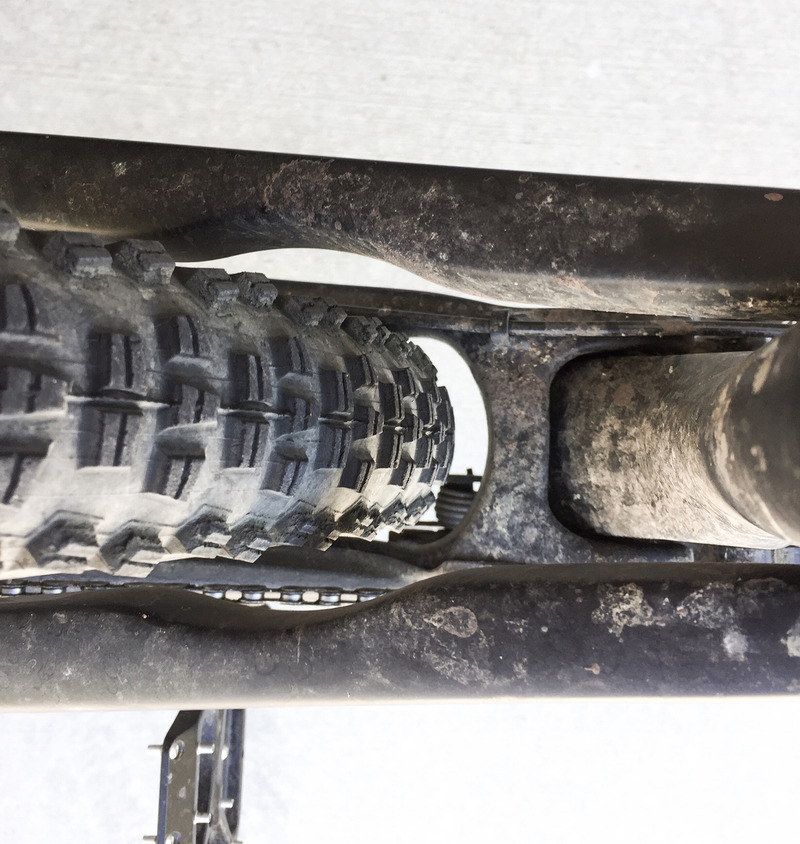 Zerode Taniwha Rear Chainstay Clearance.
Zerode Taniwha Rear Chainstay Clearance.
There are some areas to improve and this will all depend on Pinion and what they can do with the box in the near future. The "Grip Shift" on the Taniwha was a non-issue it took a few rides to become accustomed to the wrist twisting mode to shift gears. I have had a few SRAM Grip Shift bikes back in the day so I have some experience with it. There is no issue of a missed shift or of an accidental one for that matter. MX bikes ride terrain four times as rough at speeds that are much faster and having a twist throttle is a non-issue for them so why would a twist gear shift be an issue for a MTB? What needs mentioning here is the insane range that The Pinion P 12 gearbox offers. It is just over a 600% range and Rob from Zerode equates it to having a 10-60 on the rear of a standard bike! Another good thing is that every gear change provides the same ratio jump you will never shift a gear and make a dramatic change like you can with a normal 11-12spd system. If you require a different gearing setup for your Zerode you can do it but you must use the Pinion front and rear sprocket to do so. They offer a few teeth in either direction from the ones specked on the Taniwha. I would venture to say that most riders will almost never use the two top easiest gears. They are so tall that to keep a walking pace you are spinning fairly fast on the cranks! Speaking of range the ability to dump a large number of gears with the twist of a wrist is something that can become a great benefit for those that ride in terrain with large elevation changes or tighter trails. Keep in mind you can all this without having to move the cranks!
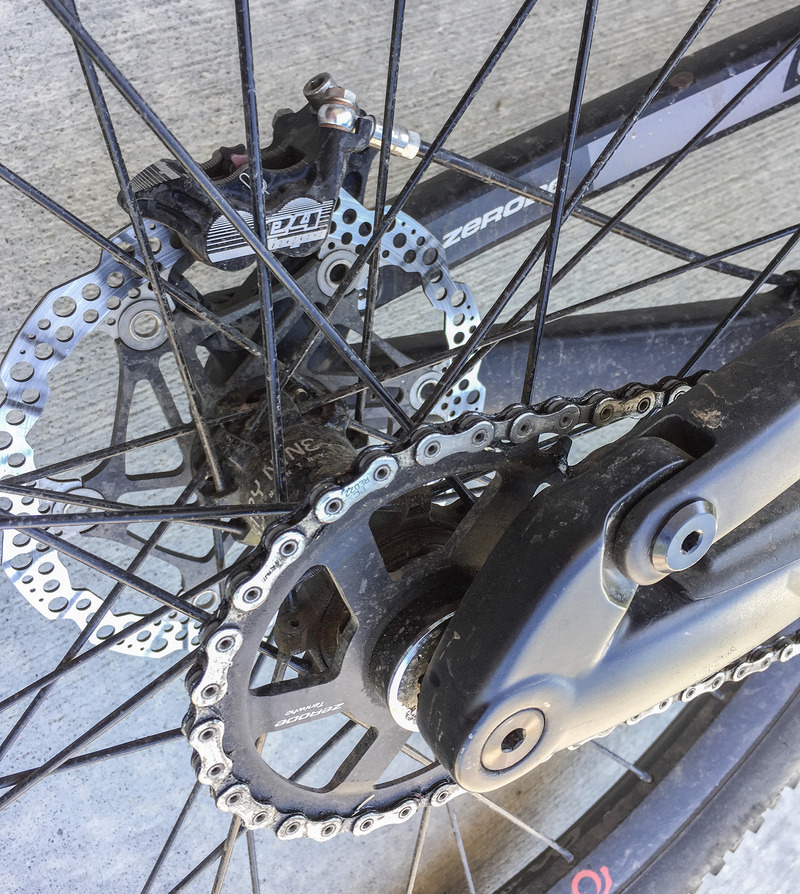 Zerode Taniwha Chainstay DetailConclusion
Zerode Taniwha Chainstay DetailConclusion
Overall we liked The Taniwha. It has a straightforward suspension design that a marketing crew doesn't need to spend millions of dollars on to convince the general public that it works. It pedals pretty well even with the X2 wide open and very little LSC on the shock. I think running the shock with a bit more LSC would have allowed us to rarely use pedal mode on the Fox shock. Even though it shares a similar suspension system with a Guerilla Gravity Megatrail it doesn't have as much resistance to pedal bob as that bike seems to. We had a CCDB Air on that so that could be the difference.
The Pinion gearbox on the Zerode moves weight off the back wheel and centers it as low as possible on the BB. This gives The Taniwha a distinct advantage over a traditional derailleur system in the suspension department. Saving almost two pounds off the back wheel makes the suspension much more active at slower speeds. Another thing that is unique to The Taniwha is it's fixed chain line that optimizes pedaling performance. It gives the bike a unique feel on the pedals and in theory is better. Going up and over rocky terrain, the bike feels like it rolls over terrain easily even when applying power. The range The Pinion offers on the Taniwha is huge and having the ability to jump between all those gears without even pedalling is pretty nice. Cornering is something I mentioned earlier and the Taniwha excels at this. This is a weak point in my riding and the Zerode provided tons of traction and a very wide body weight window. I have the tendency to weight the front too much at times and this never happened once while riding this bike. It feels as if the Zerode grants the rider and extra foot of room to make body adjustments while riding. Also worth mentioning is removing the most easily damaged item off the back wheel and eliminating it. For many, this is an issue but in all honesty, over the past 30 years of riding, I have broken about 8 derailleurs and 6 of those where during a decade of downhill racing.
So with the positives gained from running a Pinion gearbox on the Zerode Taniwha, there are also negatives. There is no denying that the Pinion adds 2.5 lbs over a traditional system and even the new C-Line version will add 2 lbs to the bike. Along with that comes its low engagement this wasn't a make or break but sometimes it was noticeable. Also not being able to shift under load is our main issue with it. It took us awhile to get somewhat used to letting up while climbing especially on steeper terrain. Everyone gets fried out and has to shift into an easier gear at one point or another during a climb. Typically I could just dump a gear and keep going. With the Taniwha I would have to stop pedaling all together to get the bike into an easier gear. Keep in mind that Pinion hasn't been around very long and with their background in automotive engineering, I would only assume that they would get their gearboxes able to shift under load at some point. The grip shift is a nonissue for us but some have complained about it in the past once Zerode said they were going to use a Pinion. There are rumors of a trigger shifter being in the works from Pinion currently. So that may change as well.
Basically, it will come down to the consumer and their needs or desires. Do you want the most efficient suspension over rough terrain or the most efficient pedaling machine? Mountain bike designs are a compromise. You give up suspension performance in favor of pedaling performance. In the case of the Zerode we gain some weight and lose out on shifting into an easier gear under load. While you gain a very active suspension attached to a frame that corners like it's on rails due to it having a very low center of gravity. Another benefit of The Zerode Taniwha will be lower maintenance and a chain that will last seasons instead of months. With a rear cassette costing close to $300 these days, it will save you money by not replacing one of those every 6 months. In theory, the gearbox proponents are correct, you can break off a derailleur it's just a question of how often that may happen to you.
Overall the Zerode was a fun bike to ride. It was very active and ate up all trail nuances with ease. Frame stiffness was very good and it cornered better than most other trail bikes we have tested. People looking for a unique bike that will prove to be low maintenance should take a good hard look at The Zerode Taniwha. We would recommend this to a friend looking for a unique "stick it to the man" do it all bike that could spend the day at the park or a day riding the local trails. Go check out Zerodeusa for more information on the Taniwha. If they only made it in 29" wheels....
Zerode Taniwha Pinion Set Up
Zerode Taniwha FAQ's
Is Grip shift the only option?
It turns out that the grip shift is a very nice match to a drive train when you do not have to pedal to change gear and the gears change instantly. If you get caught out in the wrong gear on a pinch climb you can back off for a split second and rip through a bunch of gears with a twist while the derailleur guys are trying to pedal over the top of the wrong gear or click and crunch through gears one at a time. There is no comparison in this situation. You can grab gears when coasting, back pedalling so you adapt and change when and where you shift, the grip shift lets you do this in a seamless way. I have no doubt a trigger will be available at some point. I have designed one on paper, friends have made their own but I'm not sure experienced pinion users will want to swap the grip for a trigger.
Why no horst link?
In a nut shell. I don't link them. The pedalling performance of a Taniwha is second to none. The "real" pivot design combined with a fixed chain line means it is possible to achieve very stable pedalling through the entire range of suspension travel while independently control the suspension rate via a link. With a Horst link or VVP design the virtual pivot races all over the show making it hard to control suspension rate and pedalling independently. You get a compromised design but one that marketing departments love…
Brake jack?
There is a huge amount of misinformation online about brake effect. The story goes, "single pivot designs suffer from brake Jack or brake lock out". In reality all bikes, even bikes equipped with horst links have brake effect to some degree. What happens is the traction force at the rear tire tends to rotate the suspension about the pivot whether real or virtual causing a suspension compression. It's worth noting the traction force at the rear wheel is usually small and so is the compressive effect and that the suspension is still free to respond to other inputs. Some bikes have more compression than others, in some situations this compression helps performance, in other situations it hinders performance.
I could go into an in depth analysis of brake effect. However, there is no need, motorcycles have used simple swingarm designs for over a century now, motorcycle designers fully understand brake effect and understand that a simple swingarm design is the best solution. Almost every DH world champ since records began had a bike with a brake effect essentially the same as that of a single pivot bike.
Gearbox range?
Imagine a 10-60 cassette. Enough said.
Gearbox drag?
Obviously there is an extra element in the drive train so there has to be losses. The loss is small and depends on load and gear. A comparison with a clean mech with a chain in the middle of the cassette would obviously have a standard mech come out on top. If you take into account a significant reduction in unsprung weight changing gears instantaneously and the fact the a mech drive trains efficiency falls off quickly when the chain is at the top or bottom on the cassette or when sprockets are small, then add a little bit of dirt or mud the Pinion becomes very attractive. I wouldn't use one on a road bike but a 160mm trail/enduro bike for riding proper mountain bike trails it is a no brainer .
Why a gearbox/what about the weight?
If you add a Pinion gearbox, take away a cassette (unsprung weight), derailleur( unspring weight), chain guide and build a lighter stronger rear wheel and the disadvantage is ~800g. Given that you have to power yourself and the bike up hills and overcome rolling and air resistance the extra effort required when climbing is almost not measureable. Even if it was I would happily breathe a little harder while cruising up the hills with my mates if my reward was a significant improvement in suspension performance, 600% gear range, stronger rear wheel, almost no maintenance, chains that last years, shifting without pedalling, instantaneous shifting, no chain slap, optimised pedalling etc etc I'd be very surprised if Taniwha owners go back to a derailleur.
Zerode Taniwha Grade Card
WTB Riddler Tire Test
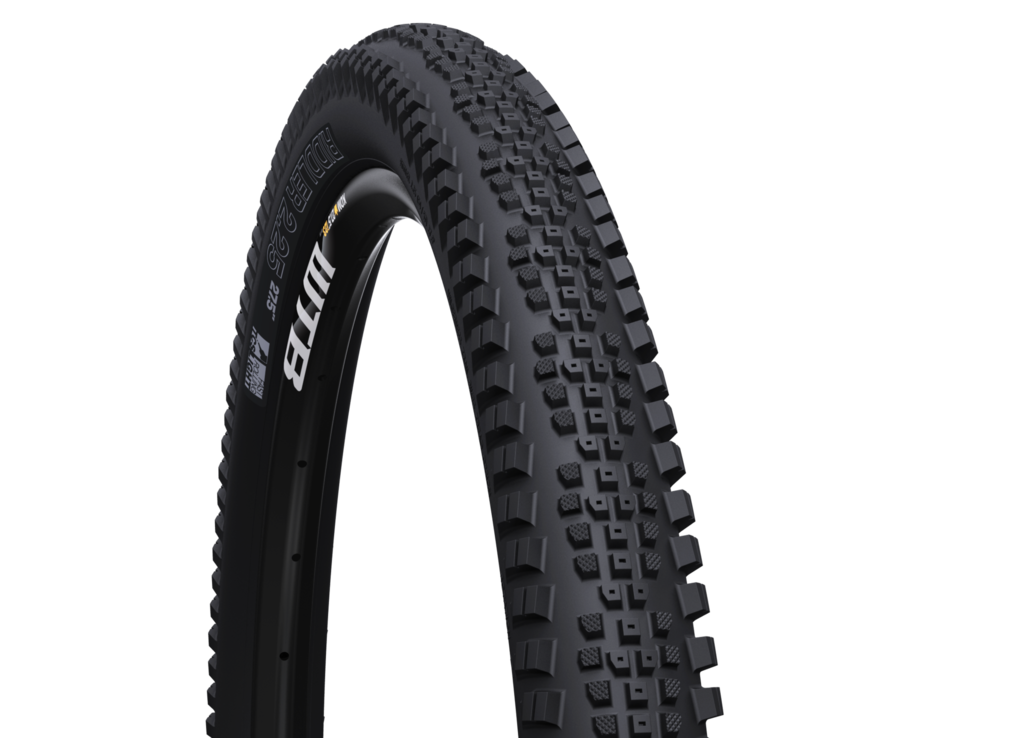
Wilderness Trail Bikes has been around a long time. They came to creation in Marin county what many consider to be the possible birthplace of Mountain Biking. The scene in the late 1970's and early 1980's was much different in Marin. The times have changed and WTB has evolved and is now making tires, saddles, grips and their own rims. We gave them a call to get a some tires to test out. Our terrain is about 85% rock with spatterings of soil the dusty kind with no traction and marbled out high speed loose trails with no berms. It takes a hell of a tire to perform well in San Luis Obispo. Using a semi slick on the back helps get me up the hill a bit easier so The Riddler was the rear tire we chose to use first.
"WTB was founded in Marin County, California in 1982, fueled by the need to create durable and reliable mountain bike-specific equipment. Back then mountain biking was a new and burgeoning sport, and mountain bikes weren’t much more than cobbled-together oddities. The original WTB crew was captivated by the experience of riding bikes on dirt trails, and they started creating more durable and functional components for their own bikes. Soon, local frame builders sought to outfit their bikes with WTB’s high-end components. WTB was able to turn our passion for bikes into a successful business.
Today WTB is a global enterprise; our innovative components are used for trail riding, transportation, recreation and elite racing across the globe. After 30 years things have changed a bit here at WTB–our little garage has morphed into a real office and the bikes we ride and the components we make have evolved to meet the needs of today’s riders, racers, and commuters. What hasn’t changed is our passion for cycling and our commitment to providing the cycling community with durable, reliable, high-performance components."
We contacted WTB to get ahold of some of their latest tire offerings. A week later we had a box with Vigilante, Riddler and Breakout tires to test out. We are running The Vigilante tire as a front tire with The Riddler as the rear tire. Many riders in our area have been raving about The Riddler since it first came out. Our terrain is very rocky, dry and loose. Basically for ten months out of the year you are riding on marbles.
"Born from the need to race in European enduro events, the Vigilante is our premier aggressive All Mountain tire, and first choice for Team WTB’s Mark Weir. The square-lugged, open-tread pattern offers stability in loose or wet terrain, while the stiff outside knobs grip at lean angles like nobody’s business. With Dual DNA (TCS) and Gravity DNA (Team Issue) rubber, this is the tire to ride when you are giving it your all."
Mounting the WTB Riddler was a snap. We did it with a floor pump and without using soap mounting them to 30mm rims!The Easton ARC did ever so slightly flatten out the Riddler's tread profile BTW. We had the 27.5 2.4 TCS Tough Fast Roll casing our tire weighed 1060 grams. That is a bit more than advertised but we have seen DH tires vary by 200 grams! If you are that worried weigh each tire in the store before making a purchase.
WTB Riddler Features
- Actual weights:
- TCS Tough-1056 grams
- TCS Light-869 grams
- Actual widths:
- 2.4: Tread-2.29" Casing-2.2"
- ETRTO 584
- Fast Roll compound is 60A durometer
- TCS Light casing is supple and conforming
- TCS Tough casing is dual-layer for protection
- Folding bead
- Round profile
- Fast rolling center tread
- Aggressive cornering knobs
- TCS - Tubeless Compatible System - Uses sealant to seal inside of tire, will NOT hold air without sealant
- Enduro Pro Nathan Riddle signature tire
- Made in China
- WTB part #'s:
- TCS Light, Fast Roll-W010-0586
- TCS Tough, Fast Roll-W010-0587
Our first ride on the Riddler was on a trail that we ride every week. It is about 700 feet to the top and getting back down it takes around 4 minutes. There had been a good deal of rain the last few weeks so our soil that usually feels like you are riding on ice was actually providing decent traction. Entering the first few turns I was shocked how much bite the tire was offering both in braking and while being leaned over. I was a bit worried with it being a semi slick. The soil around here is clay based and packs up quick! The fourth turn on this trail is a severe off-camber left hander that is very sharp about 120 degrees the front of the bike offered copious amounts of grip and i just got the Riddler to brake loose with a hard pull on the brakes. We are running 203mm rotors and Hope Tech 3 V4 brakes and The Riddlers resisted breaking loose in shocking fashion.
The next trail is about 900 feet to the top. Fast times going down are about 2:30 or so. This trail has a rock garden that is about 300 yards in length. After that you enter the trees and begin riding on a hard pack dirt. This section is very fast and filled with fast gradual turns. I was running 25 PSI on the front tire and just below 30 on the rear. Even though we had the fast roll version the rear tire offered very good traction in the baby heads. Lower down the trail the Riddler did well in the high speed hard pack.
San Luis Obispo is know for having fast loose and rocky trail. That was what the next trail is know for. I can do it in 9 minutes the record is in the low 7 minute range. On this trail you can easily get up to 30 mph on the top section. It is fire road width and filled with good size embedded rocks (the kind that pinch flat) and for good measure these are coated with smaller loose rocks to make it extra slippery! I pinged my rim a few times hard and the tires had no issue. There are a few corners that are long and off camber and when riding an aggressive trail bike you need to be pressing the front end down. WTB seemed to have done a good job with The Riddler they offered good traction on the loose rocks. I know the sticky version would have been even better. These are semi slicks so ruuning a full tread tire would have offered more grip over the loose stuff.
There is a trail in town that is short and pretty rocky. Not exactly Santa Barbara rocky but has some good size rocks in it. The rocks here range from golf ball up to beach ball in size. They are almost all round so it can be fun to bounce through them. Tires that are super sticky will allow a rider to cut edges off of these rocks easily. The WTB Riddler was almost able to do this. Having aggressive side knobs helped the tires stick to the rocks. Riding large rocks like this is not very challenging for the modern tire to get good traction on. This is more a test of its ability to avoid pinch flats. It slid off of some of the smooth rounded rocks and others it held enough traction to let me glide over an edge. Overall the tire did very well and in fact I got one of my fastest times down this trail and I had not ridden it in almost 6 months!
Being close to the ocean provides us with trails that are more sand based. These are great to ride post rain or even during the rain. I went out here and made my way up the hill it is about 800 feet to the top. fast riders can get down in under 8 minutes it usually takes me 9 minutes. This trail is very fast to start then you drop down into a valley and it is filled with turns and rocks. Lower down you are floating on top of a fine sand layer and things can get twitchy at speed. The WTB Riddler did well on this sand filled trail when it was wet. The tire held traction in the turns and had no issues crushing over the rocks. Lower down it floated its way over the sand without issue. I went and road this during a heavy downpour and the tires worked incredible in these lower sandy turns BTW. When the trail dried out a bit they began to fight the trail for traction while using the brakes and not being leaned over.
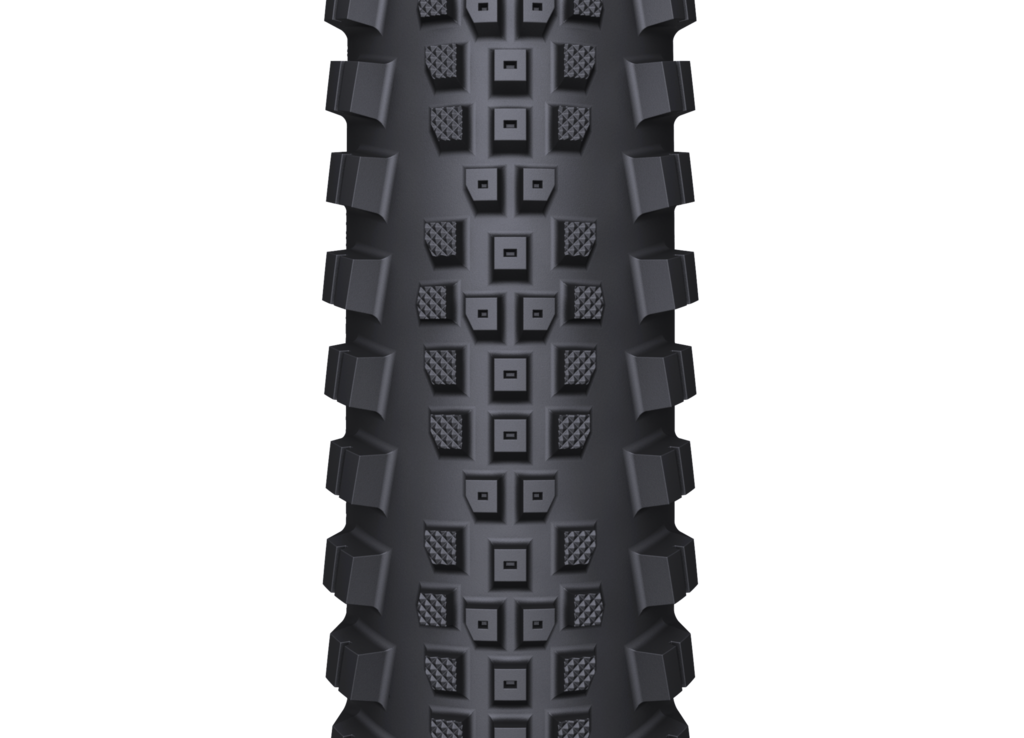
Conclusion
Overall I was impressed with The WTB Riddler tire. It worked well as a rear tire on our traction deprived trails. They did a good job making a tough casing that will tolerate low PSI and not tear of flat easily. The tire did well in rock, hard pack and decent sandy trails. I also did some riding when it was pretty wet out and it did decent in light mud as well.
It rolls pretty fast and has good grip once you lean the tire over. Deciding if the rolling resistance benefit if worth the traction decrease in straight line braking will largely depend on your soil and riding ability.
This isn't the lightest tire out there some other companies offer tires around 900 grams but you have to ask yourself if a 200 gram savings is worth a flat or destroyed rim. WTB does make a lighter version if weight is a big concern for you. Having a tire that sticks in varying terrain is great. This is a tire I would highly recommend to a friend. Down the road when looking for a semi-slick rear tire The WTB Riddler will be on the short list.
WTB Riddler Questions
1. Give us a “quick” history of WTB.
Started early with the idea of doing what was not already done. Making parts to provide for complete bikes led to surplus production and bike shop sales. Maturing markets took WTB from designing for others to promoting the WTB brand and production in Asia for OE and replacement parts. The soul has never been lost though the price point pressure is high.
2. What goals or concerns did you have when designing the Riddler?
Rolling fast on the straightaways, while still having the ability to dig in while corner. Those were the two primary goals when designing the Riddler. We found that, in certain conditions, ensuring traction with the tire upright required only a minimal amount of tread prominence along the centerline of the tire. In an upright position, with the rider's weight directly over the centerline, we didn't need tall knobs to keep the tire from sliding. Yet, of course, the knobs were still needed on the outer edge to deliver bite when the tire was leaned over.
3. Was weight, reliability or traction the biggest concern?
Though we wouldn't say that weight was specifically our biggest concern, being fast rolling and minimalistic was the focus. We aimed to reduce rolling resistance and increase speed without sacrificing traction where it is needed most. With the Riddler 2.25 275" TCS Light tire coming in at only 780 grams, it's amazing how much grip it delivers while still being a resilient tire.
4. Who created the tread design?
WTB has a variety of people that have an influence on how the various tread patterns produced get done. In order to ensure we approach the design from numerous angles, we never leave the design process up to a singular person. In this case, Evan Smith, WTB's product design engineer, teamed up with longstanding WTB athlete Nathan Riddle to create the tire. Riddle came to us with specific needs for a tire that hooked up on race day without slowing the pace. Riddle was such a driving force behind the Riddler than it was a clear choice to name the tire after him. Click here for a more in-depth story behind Nathan Riddle's involvement with developing the Riddler.
5. What widths is the Riddler available in?
For 27.5-inch versions, the Riddler is available in both 2.25 and 2.4-inch widths, while the 29-inch version is currently available solely in the 2.25-inch width. While all Riddlers are available with a TCS Light / Fast Rolling casing, the 27.5" 2.4 version is also available as a TCS Tough / Fast Rolling version.
6. What about a tire with multiple durometers? (60/42)
The Riddler is in fact dual durometer. Initial production tires of the Riddler were 60/50, though we've since made a running change to 60/45. With a tread pattern as specific as the Riddler, using a dual durometer rubber compound is the only way to go when you're combining a fast rolling design with meaty knobs.
7. When will a fat bike win an EWS race?
When it all freezes over and flotation is the only way to make time and speed.
8. What would help the bike industry the most? ($, lowering cost, more trail access)
More people on more bikes more often in more places. If the bike industry makes more money, it will most likely put it into product technology and marketing. Most companies won’t spend a large part of the profit on advocacy, as WTB does. We spend so much on bike advocacy that it actually harms our business at times. Lowering cost is a human rights issue. We don’t support low quality of life for the people who make bike parts and nor should anybody else. Lack of trail access can make it hard, or impossible, to ride mountain bikes in an efficient manner. You see this in areas where the only way to get in a good ride is to jump in the car and drive hours. You basically have to take a half, or whole, day to go on a decent ride when driving is involved. Easy access to trails for everyone will allow bike sales to flourish.
9. Who is the better rider Nico, Tomac or ACC?
If you ain’t first, you’re last! Let the results do the talking. We are not fit to judge. Better yet, ask each of them about the other.
10. How is the hiker/biker conflict in Marin these days?
Cooled out for the most part. The best interaction is none at all. In the last couple of years we’ve seen a lot more public discussion between both parties on the issue of trail access, and how to best share the open space that we all enjoy. Facilities like the Stafford Lake Bike Park opening up provide great opportunities to showcase our cycling community, as well as teach up-and-comers bike skills and trail etiquette. We think things will only improve given the amount of cyclists in Marin, it just takes time and careful planning.
12. What is with all the new “standards” the last 5 years?
Improving the breed requires vigilance. Standards do not become “standard” unless they are worthwhile. And just like science they are only as good as the current best effort and knowledge.
13. Can America make a race organization that will surpass the UCI? Like real payouts and corporate sponsorship?
That is doubtful, for now. Mountain bike riding is increasing in the states, mostly due to NICA (National Interscholastic Cycling Association), which is getting the next generation of riders on bikes. In turn, more parents and family members of these youth are getting on bikes as well. This builds fans of the sport, and fans of racing, which will ultimately feed America’s hunger to have more high-level races on our home turf and increase support for the organization of a solid cycling federation. Surpassing the UCI is a hefty goal, but thinking bigger is how we get outside the box.
14. Anything you want our readers to know about the Riddler?
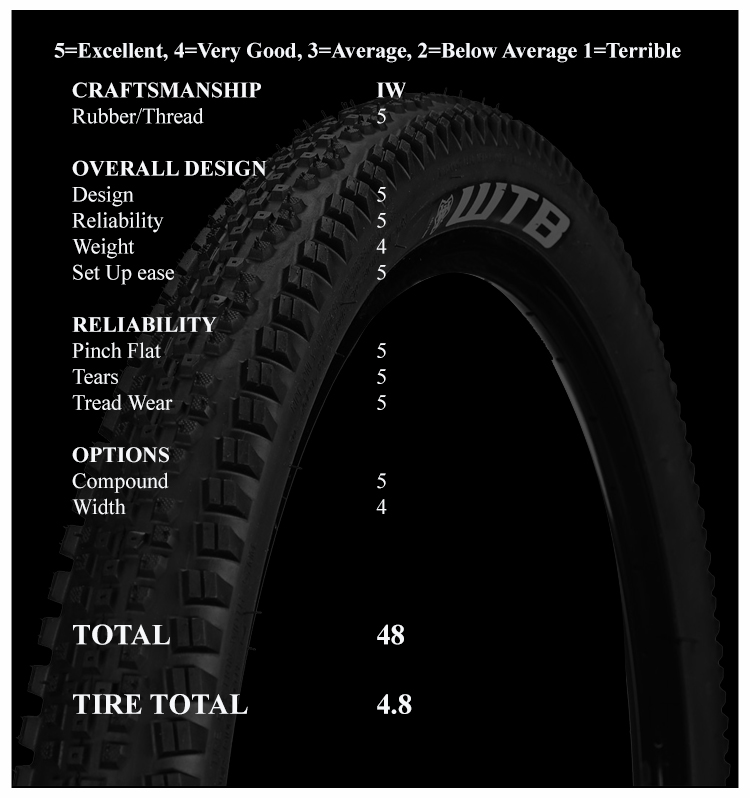
 650b,
650b,  Riddler Test,
Riddler Test,  Semi-Slick,
Semi-Slick,  WTB Riddler,
WTB Riddler,  WTB Tire Test |
WTB Tire Test |
Devinci Django Test
The mountain bike market as we know it has changed and become much more specialized over the last five years. Bikes are now broken down into very specific categories and the only bike that now seems to cover two genres is the Enduro bike. It is a climber as well as a descender with a stronger emphasis on going down.
Devinci released the Django as an aggressive trail bike. these are shorter, lighter version of their Enduro counterparts. These bikes will climb better and be a bit easier for longer rides in general. They do however give up a fair amount of comfort once trails get rocky and rowdy!
We took a break from the longer travel Enduro bikes and decided to test out Devinci's go at a short travel all mountain slayer the Django. it was noticeably lighter than our last bike and was a full factory build. We had to get used to Shimano brakes and drive train again but that only took a few rides.
Devinci History
"Aluminum was the seed that set a two-wheeled revolution in motion, when Devinci Bikes landed in Chicoutimi, Quebec, more than 25 years ago. From road to race to carbon and dual-suspension line-ups, today Devinci stands as a global frame-manufacturing leader, home to cutting-edge R&D facilities and a top engineering squad committed to the ultimate ride.
Its story starts in 1987, when Devinci began life as Da Vinci (as in Leonardo), a company envisioned by two local engineering students. Soon after, road biking entrepreneur, Felix Gauthier, entered the mix. By 1990 he had purchased half the company, swapped vowels, and Devinci proper was born.
From the outset it wasn’t always smooth roads for this fledgling Canadian-born brand. Perfecting the heat-treatment processes was a game of trial and error. Money was tight, distribution channels were slim, and when a costly new oven threatened to break the bank, Gauthier and his team combined ingenuity and talent to build one themselves. With a growing set of tools and skills in place, Devinci went to work cooking more bikes. By 1993, distribution had expanded, Gauthier had taken sole ownership of the business, and Devinci moved from its modest 800-square-foot home to one four times the size.
Brainpower was corralled; designers and skilled technicians were sourced; R&D was ratcheted up, reinforcing a commitment to quality and performance. From Canadian market exclusivity, Devinci branched worldwide, expanding its road repertoire to include an array of women-specific rides, hybrids, XC standouts, ergonomic cruisers, and a World Cup winning dual-suspension mountain bike lineup—featuring Dave Weagle’s patented Split Pivot technology.
Today Devinci’s creative engine revs under one roof. This includes a state-of-the-art on–bike testing system, which measures every stress and strain in real life situations. Changes to a particular design can be prototyped, tested, tweaked, and re–tested in days rather than weeks.
This detailed ethos equates to value and efficiency, as well as industry-leading quality control and R&D efforts poured into every bike launched at Devinci HQ."
Devinci Django
"Freedom on the bike is all about breaking from the starch and sending it into the dirt-sphere with power, speed, and finesse. Devinci’s new Split-Pivot Django actualizes those aspirations on the trail, with an optimal blend of 130mm front/120mm rear suspension. Surefooted 27.5 wheels enhance traction on wet, slippery surfaces and deliver appreciated stability. And alloy and carbon frame architecture augments punchy acceleration with precision handling and a lively overall feel. Whether sticking fierce, fast descents or finding optimal flow over upturned environments, Django seizes the opportunities ahead. Its lifetime warranty fuels the advance. *Image may not show accurate specifications. Please refer to specifications below."
Django XT Build Kit
- Carbon DMC-G 120mm
- RockShox Pike RCT3 27.5 Solo Air 130mm
- FSA Orbit 1.5 Zero Stack w/SL bearing
- RockShox Monarch RT3 7.25x1.75 DB High Volume Eyelet
- Schwalbe Hans Dampf 27.5x2.35" Trailstar SnakeSkin TL
- Schwalbe Rock Razor 27.5x2.35' Pacestar SnakeSkin TL DT
- Swiss X1700 Spline 27.5 15x100mm
- Shimano RT81 180mm Centerlock Shimano XT M8000
- Shimano RT81 160mm Centerlock Shimano XT M8000
- 11s Shimano XT M8000
- RaceFace Next SL 30T
- Shimano 11s 11-42T
- Shimano 11s
- Race Face Next ¾ Rise 31.8mm 725mm
- Race Face Turbine 31.8mm
- SDG Bel-Air Rock
- Shox Reverb Stealth 125mm 31.6mm
- Alloy CNC 37mm Black
- Devinci Performance w/lock-on
- 12.38 kg / 27.29 lbs
Devinci Django Frame Features
- 5th generation of all mountain Split Pivot frame. New geometry with a top tube 20 mm longer on all sizes to fit a wider range of customers
- Tapered head tube Precise control and the best strength-to-weight ratio in the business
- Lower stand-over height Delivering prime stand-over fit, and a super-low center of gravity for enhanced handling
- DMC-G Devinci monocoque carbon. Lighter, stiffer, more responsive. Featuring EPS molding with T700 carbon fiber
- Ultra-short chainstays Pin-it acceleration, combined with superior driver's seat handling
- Split pivot Suspension system. Separates acceleration forces from braking forces for synchronized feel
- AXIS & FRG ADJUSTABLE Perfect balance, minimum unsprung mass, and prime hi/lo geometry adjustment for perfect settings
- Boost 148 standard Stiffer rear wheel
- Internal cable routing Protection from elements. Deluxe, aerodynamic styling
- Asymmetrical construction Milking the most performance out of every frame angle, improved torsional stiffness
- 27,5 dedicated 2.35'' maximum tire clearance
- Increased bottom out force Increased progressivity for improved bottoming out forces
- CUSTOM TUNED REAR SHOCK
Split Pivot Suspension
"SPLIT-PIVOT is a newly patented Dave Weagle suspension system for high performance bicycles, where traction, efficiency, maneuverability, and frame stiffness are important factors on the track and trail. Shaped by DW's competition proven engineering, SPLIT-PIVOT offers true performance advantages over single pivot bikes, with a ride that's sure to make you smile.
- SPLIT-PIVOT's [concentric dropout pivot] is the heart of this new design. The [concentric dropout pivot] and Dave Weagle's engineering allow for performance features that no single pivot can duplicate.
- SPLIT-PIVOT separates acceleration forces from braking forces in the suspension The system reduces excess suspension compression due to acceleration forces, and at the same time reduces excess compression due to braking forces.
- Braking neutrality can be tuned independently of acceleration characteristics, and leverage rate curves can be tuned to meet the needs of the application.
- SPLIT-PIVOT can be engineered to build lightweight frame structures without resorting to exotic materials or tube shapes.
- Featuring 12mm thru axle, QR 12mm axle, or 10mm vertical QR possibilities, plenty of stock wheels fit the design.
- Bottom Line: SPLIT-PIVOT is a patented DW suspension that can be engineered to offer a ride that will make you want to be on your bike more often."
Devinci Django Geometry
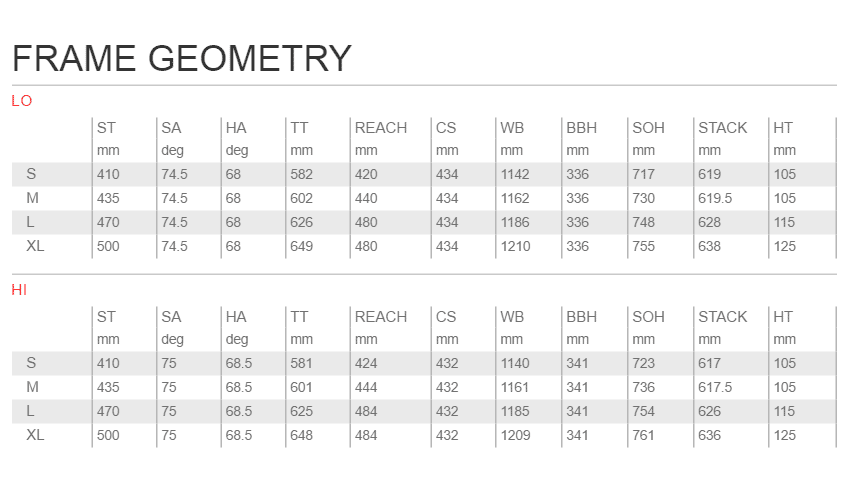
The first trail climbs about 700 feet in just over 1 mile and I could tell The Django had a 5 lbs weight savings over the bigger bike. It's overall platform felt much stiffer as well and a bit less forgiving while climbing. I was only a minute behind my normal time of 18 minutes to get up which is not bad considering how much time I had off.
Once at the top I strapped on my bell and goggles and got ready to drop in. The first part is high speed and fire road width with a good scattering of rocks. I could tell right away The Dgango was a bit less forgiving when hitting bigger rocks than the past bikes we have tested. It was time to hop over these instead of just steam rolling them like we do with the bigger bikes.
The trail takes a hard left through rocks and enters a very high speed off camber single track section. there are some large rocks here you dodge and weave your way through. After that it goes right back across the mountain through some ruts and up and over a steep roller that acts as a G-out and typically uses most of a bikes suspension when hitting it at speed.
This trail is somewhat smooth compared to others in the area. I was able to get within a few seconds of my fastest time on my second time down the trail so this is a bike that inspires confidence.
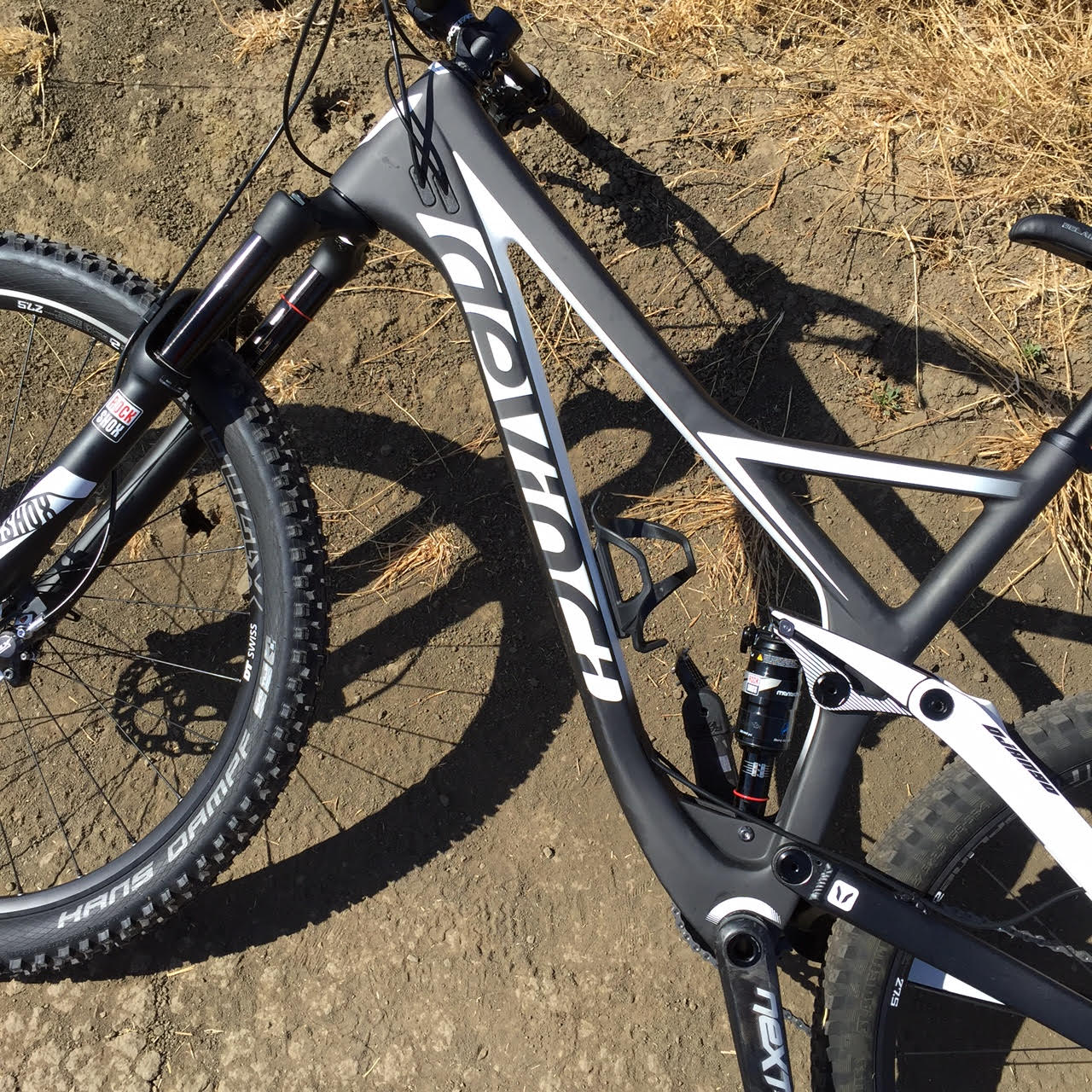
Overall the bike seemed to provide a solid pedalling platform. Whether standing or sitting the bike bobbed very little we ran it in pedal mode on the rear shock about half the time. On a few occasions on the descents we left the shock in pedal mode just to see how it would feel and honestly you couldn't tell except for the small bump sensitivity.
The Devinci Django proved to be a more trail oriented type of bike. It's shorter travel and firm suspension stroke begged for smooth line choices and pumping your way down the trail to keep up the speed. Having ridden the more aggressive Enduro bikes recently what we came away with was that The Django can make for a rougher ride over rocky terrain. Smoother terrain and flow based trails are where The Django shines. It can carry speed and cover terrain very quickly with a skilled rider behind the bars. The Split Pivot Suspension designed by Dave Weagle feels good. Setting up the bike was pretty easy. We actually didn't need to add any rings into the rear shock. We ran between 25%-30% of sag on the bike. It was very progressive and we never had an issue with excessive bottoming out on the trail.
Riding The Devinci Django it became apparent that Weagle's design goals of a stiff, efficient and neutral braking frame have been achieved with The Django. I weigh 220lbs and can usually detect frame and wheel flex pretty fast. The Django felt very stiff and gave a very neutral braking feel. Acceleration, and climbing while providing a firm pedaling platform is something the Django does well. The tradeoff is that the bike provides a stiff ride on the way down and you have to be hauling ass to get the suspension to soak up the smaller stuff. This won't bug most riders but it should be noted. If you live in Santa Cruz or flow filled Nirvanas then it won't be an issue.
The Devinci Django is a fast bike it wants to be pressed into the turns and pumped out of them. Tires are something that can get chewed up around here fast. The trails are very rocky so we yanked off the back tire and ran a GRID casing Specialized to play it safe. It added some weight but was well worth it. With our Hope flat pedals our XL complete bike weighed 31lbs.
Conclusion
Overall we liked The Devinci Django with its short travel can do attitude. It was very playful and poppy, a bike you could launch off or over anything to big to run over. Carrying speed helped to keep the suspension active and absorbing all the terrain passing under your tires. Pumping your way down while avoiding the big stuff will keep you covering ground in a hurry.
People looking for a short travel aggressive trail bike that can handle 50 mile days and descend most terrain easily will love The Django. It provides a stable pedalling platform in a stiff chassis. Rider input is instantly translated into bike movement overall it is a very lively ride. Devinci did a good job with the bikes overall geometry. We ran wider bars and beefier tires to avoid sidewall tears.
It has been close to a decade since I have ridden a Shimano drivetrain and I was surprised by how will the XT 11spd worked. It clacks much harder between gears than SRAM stuff does so that took a bit of time to get used to. Overall the build was good. One thing worth replacing would probably be the wheels just beat the hell out of them and swap them for something wider and stiffer down the road.
There are some very rocky tails in this area and that is when you will notice the short travel of the Django. Hitting that stuff at speed transfers chatter into the bars and pedals. This was the only time we found the short travel holding us back. Overall it's agressive geometry, great suspension and stiff chassis make The devinci Django one hell of a fun ride.
We would reccomend The Django to a friend looking for a short travel bike. If they are looking at XC bikes I would suggest they check one of these out. If they already own a DH bike but want something to train on the Django could be the answer! Shortly after we got the 650b bike Devinci announced The 29" Django which should prove to be a bit better as smoothing out rough trails. Another bike sporting a Dave Weagle suspenion system that is awesome imagine that......
Devinci Django Questions
1. Give us a Devinci history lesson.
http://www.devinci.com/company/index.html
2. How do bikes go from ideas to production at Devinci?
https://freehubmag.com/videos/made-love
3. How did the idea for The Django begin?
With the Troy being updated with a burlier frame and now being more at the All-mountain crowd, it left a space for a new bike in our offering. Being based on the east coast, we wanted a bike that would be punchier than the Troy to handle the rolling terrain that we have here. That’s when we decided to go with a smaller travel bike (120mm in this case) that would remain very capable but would give a better punch.
4. Was it a hard choice to decide on a 120mm travel bike for you guys?
No, as previously said, this falls naturally in our lineup.
5. What where some of the main features you guys wanted in the Django when you were laying it out on paper (computer)?
We wanted a bike that feels more capable than the typical 120mm bike but also that feels very lively. A bike that makes the climbing less painful and bring some fun to it. True to Devinci’s design, we wanted to have short CS and low BB as well as low stand over height to make sure the bike is fun to ride.
6. Did you achieve all the elements into the final product?
We did and we are stoked on the final product. No need to say that this bike has been the ‘go to’ option for many of our staff.
7. Any updates you guys are looking to do to the Django in the near future?
The Django saw a few spec change for 2017 like dropper post and wide bars on all models, including entry level. Other than that we are pretty stoked on the bike.
8. Care to elaborate on geometry used on the Django?
We wanted something that feels capable but remain nimble and fun. So short CS, low BB, HA that enable to handle the steeps while remaining lively on the trail.
9. Rocky or jump filled trails?
Jump filled on the 27.5, Rocky on the 29er.
10. Where are your carbon bikes made?
Aluminum are 100% made in Canada. Carbon bikes are designed, tested, assembled in Canada but frames are manufactured in Asia.
11. Who is the best Mountain Biker ever?
Stevie Smith
12. Any new bikes you want our readers to know about?
All our 2017 models are now online, check it out !
13. What do you think about all the new standards that have popped up in the last 3 years?
As long as it makes the ride and the bikes better it’s worth it. However it is definitely a challenge for us in terms of frame conception and parts spec.
14. What would make the bike industry better?
More trails and more people to maintain them.
15. Will Devinci be making a long travel 29” anytime soon?
Only future will tell.
16. Anything else you want to get across to the readers?
Have fun on the trails !
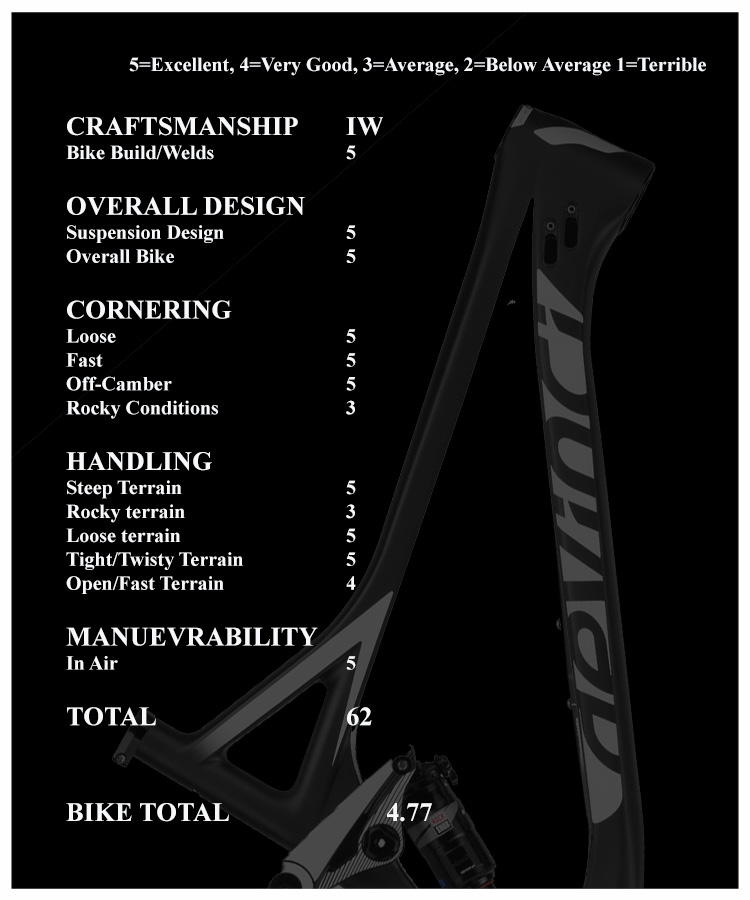
 650b,
650b,  Devinci Bikes,
Devinci Bikes,  Devinci Cycles,
Devinci Cycles,  Devinci Django,
Devinci Django,  Django Test,
Django Test,  Enduro,
Enduro,  Mountain Bike,
Mountain Bike,  Trail |
Trail |





